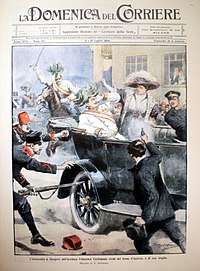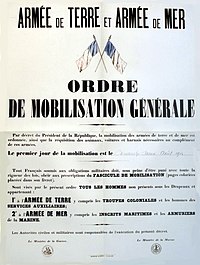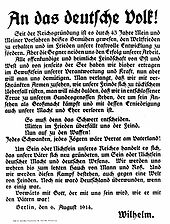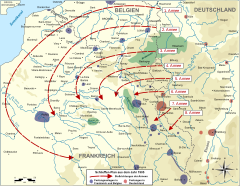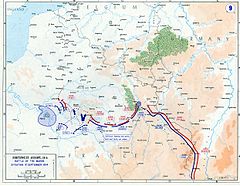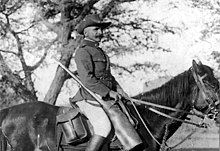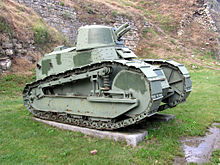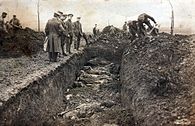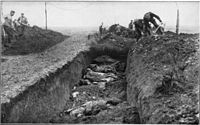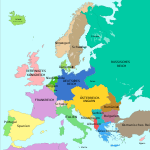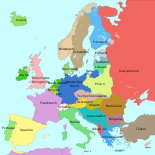World War I
The First World War was fought from 1914 to 1918 in Europe, the Middle East, Africa, East Asia and on the oceans. About 17 million people lost their lives in it. It began on July 28, 1914, with Austria-Hungary's declaration of war on Serbia, preceded by the Sarajevo assassination on June 28, 1914, and the resulting July Crisis. The armed conflict ended with the Compiègne Armistice on November 11, 1918, which was tantamount to the victory of the wartime coalition that emerged from the Triple-Entente. Major participants in the war were the German Empire, Austria-Hungary, the Ottoman Empire and Bulgaria on the one hand, and France, Great Britain and its British Empire, Russia, Serbia, Belgium, Italy, Romania, Japan and the United States on the other. 40 states took part in the most extensive war in history up to that time, and a total of nearly 70 million people were under arms.
In the Sarajevo assassination, the Austrian heir to the throne, Archduke Franz Ferdinand, and his wife Sophie Chotek, Duchess of Hohenberg, were assassinated by Gavrilo Princip, a member of the underground revolutionary organization Mlada Bosna, which was or had been linked to Serbian officials. The main motive was the desired "liberation" of Bosnia and Herzegovina from Austro-Hungarian rule with the aim of unifying the southern Slavs under the leadership of Serbia.
For action against Serbia, Austria sought the backing of the German Empire (Hoyos Mission), since intervention by Russia as a protecting power had to be expected. Kaiser Wilhelm II and Reich Chancellor Theobald von Bethmann Hollweg pledged their unconditional support to Austria-Hungary in early July. The issuance of this so-called blank check marked the beginning of the July crisis. On July 23, Austria-Hungary ultimatively demanded that Serbia conduct a judicial investigation against the participants in the June 28 plot involving imperial and royal organs. organs. This was rejected by the Serbian government, encouraged by Russia's promise of military support in the event of conflict, as an unacceptable encroachment on its sovereignty. Russia's attitude, which was partly determined by the pan-Slavic motive, was again supported by France in the course of the French state visit to St. Petersburg (July 20-23), which, reaffirming the French-Russian alliance, guaranteed the Russians support in the event of war with Germany. On July 28, 1914, Austria-Hungary declared war on Serbia.
The interests of the great powers and German military planning (Schlieffen Plan) caused the local war to escalate within a few days to a continental war with the participation of Russia (German declaration of war on August 1, 1914) and France (German declaration of war on August 3, 1914). The political consequences of the Schlieffen Plan - bypassing the French belt of fortifications between Verdun and Belfort, German troops attacked France from the northeast, violating the neutrality of Belgium and Luxembourg - led to the entry of the Belgian guarantor power Great Britain and its dominions into the war (British declaration of war of August 4, 1914), which led to its escalation into a world war.
The German advance came to a halt at the Marne in September, and between November 1914 and March 1918 the front in the west stiffened. Since Russia continued to participate in the war in the east until the October Revolution of 1917 and the separate peace treaty of Brest-Litovsk, Germany found itself in a two-front war for a long time, contrary to planning. Typical features of the fighting included positional and trench warfare as well as material battles with high casualties and mostly only minor gains in terrain. This was the case, for example, in the Battle of Verdun, the Battle of the Somme, eleven of the twelve battles in the Isonzo and the four battles in Flanders. The gas war, the unrestricted submarine warfare - which resulted in the U.S. entering the war against the Central Powers in 1917 - and the Armenian genocide, which was related to the war effort, are considered special escalation stages.
Russia's withdrawal from the war effort after the Separate Peace with the Bolsheviks made possible the ultimately unsuccessful German Spring Offensive of 1918, but supply shortages resulting from the British naval blockade, the collapse of the allies, and developments on the Western Front during the Allied Hundred Days Offensive led the German military leadership to assess that the German front had become untenable. On September 29, 1918, contrary to all previous pronouncements, the Supreme Army Command informed the German Emperor and the government of the hopeless military situation of the army and, through Erich Ludendorff, made an ultimate demand for the opening of armistice negotiations. On October 4-5, 1918, Reich Chancellor Max von Baden petitioned the Allies for an armistice. By seeking the hitherto avoided, almost hopeless decisive battle with the Grand Fleet in the spirit of an "honorable demise" with the fleet order of October 24, 1918, the naval command aroused the resistance of sailors, who refused the order in growing numbers and as a result triggered the November Revolution. On November 11, 1918, the Compiègne Armistice came into effect. The terms of peace were settled in the Paris Suburban Treaties between 1919 and 1923. Of the losing powers, only Bulgaria was able to retain its pre-war state structure; the Ottoman Empire and the Austro-Hungarian Empire disintegrated; in Russia, the Tsardom declined; and in Germany, the Empire.
The First World War was a breeding ground for fascism in Italy, National Socialism in Germany and thus became the precursor of the Second World War. Because of the dislocations that the First World War triggered in all areas of life and its consequences, which have continued to have an impact into the recent past, it is considered the "primordial catastrophe of the 20th century". It marks the end of the age of (high) imperialism. The question of who was to blame for the outbreak of this war is still the subject of controversial debate today, and the corresponding Fischer controversy has in the meantime become part of German history. In the cultural sphere, the First World War also marked a turning point. The many thousands of front-line experiences in the trenches, the mass deaths and the upheavals in everyday life caused by hardship changed the standards and perspectives in the societies of the countries involved.
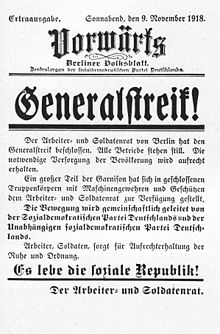
Against the backdrop of defeat, the November Revolution develops out of the Kiel sailors' uprising: issue of Vorwärts, November 9, 1918
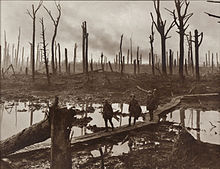
The Chateau Forest (Schlosswald) near Ypres consisted of nothing but tree stumps after the intense artillery bombardments (1917). Large parts of Belgium and northern France were devastated during the war

Tanks gained increasing importance from 1917 onwards despite technical problems and were essentially only available to the Allies: British Mark IV during the Battle of Cambrai
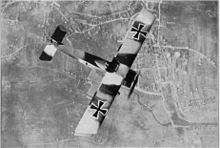
Air warfare became more and more important in the course of the war, but was not yet a decisive factor in the war as a whole (Photo: 1917/18)
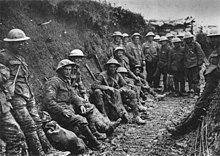
Trench warfare was characteristic of the Western Front: British soldiers of the Royal Irish Rifles in a trench on the Somme, autumn 1916.
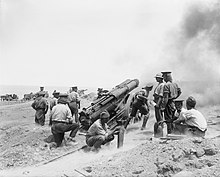
Artillery played a decisive role in the war effort: here a British 60-pounder cannon at Cape Helles, Gallipoli (1915)

The decisive battle at sea expected by all sides failed to materialize. Submarine warfare developed into the most significant aspect of naval warfare in World War I and was a major reason for the United States entering the war
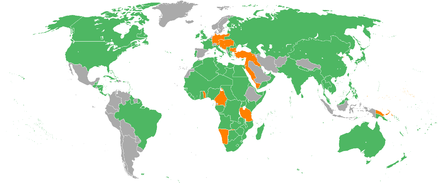
World War I - participating states Entente and Allies Central Powers Neutral
| The assassination in Sarajevo on June 28, 1914 - on the left in a not entirely accurate contemporary depiction - was followed by the July crisis and mutual mobilizations, on the right by the order for French mobilization on August 2, 1914 | ||
Previous history and initial situation
High Imperialism
Before 1914, Europe was at the height of its global dominance. As a result of the industrial revolution and population explosion, Europe, together with the powers Japan and the USA, which had also been acting imperially since the end of the 19th century, had succeeded in establishing global political domination (colonialism). Essentially, only China was able to maintain its independence; before 1914, only the U.S. and the Spanish colonies on the American double continent and, with restrictions, some white dominions succeeded in decolonizing. The establishment of the French protectorate over Tunisia (1881) and the British occupation of Egypt (1882) had given imperialism a new quality insofar as the European states again increasingly sought formal rule over newly acquired territories. This became visibly a matter of national prestige, as the strength of European states seemed to be defined in the public perception by their non-European position. Inevitably, this shifted the tensions that had arisen in the periphery back to the continent, especially when, in the 1890s, the division of the world was essentially completed without Italy and the German Empire having received a share commensurate with their self-image.
Crises
With the founding of the German Empire, an imbalance had arisen within the European pentarchy; the German Empire emerged from what had previously been the weakest power (Prussia). The German annexation of Alsace-Lorraine permanently stood in the way of an understanding with France. Security interests, national prestige and economic interests clashed more intensely in this constellation of powers. Apart from that, domestic tensions and fears of threats contributed to the fact that the ruling elites and governments were inclined toward a risky policy in order to distract attention from internal deficiencies through foreign policy successes. Thus, in the age of imperialism, peace-threatening crises increasingly developed:
- In the war-in-sight crisis (1875), Russia and Great Britain made it clear that they would not accept a renewed defeat of France. Without being involved in alliance systems, these powers reacted according to their great power interests, as they did later in the July crisis.
- In the Balkan crisis (1875-1878), a local conflict developed into a small-scale war (Serbian-Ottoman War) and from this the Russian-Ottoman War of 1877/78. The Congress of Berlin ended the crisis, but in the process deepened the rivalry of Austria and Russia in the Balkans and worsened German-Russian relations.
- French Boulangism exacerbated tensions between Germany and France (exemplified in the Schnäbele affair of 1887), especially during Georges Boulanger's tenure as minister of war (January 1886 to May 1887), and led to the revival of revanchism.
- The Bulgarian crisis - namely the Serbian-Bulgarian War of 1885/87 - significantly worsened Austro-Russian relations.
- The Fascoda Crisis (1898) and the Second Boer War (1899-1902) "signaled the filling of colonial power vacuums overseas [...] by European-North American imperialism around 1900, so that tensions on the periphery returned to Europe."
- In the First Moroccan Crisis (1904-1906), Germany tried to break France, isolated by Russia's weakness (Russo-Japanese War 1904/05, Russian Revolution 1905), out of the Entente cordiale, but failed at the Algeciras Conference (1906). On the contrary, the attempt led to the unmistakable isolation of the German Empire, which subsequently became all the more closely tied to Austria-Hungary.
- The naval battle at Tsushima (May 27, 1905) and the Russo-Japanese War of 1904/05, which Russia effectively lost, brought about a reorientation of Russian policy. After the loss of the East Asian position and in view of the British position in the Middle East, the urge to expand the zones of influence was oriented back to Europe and especially to Southeastern Europe, which brought about the conflict with Austria-Hungary.
- The Bosnian annexation crisis of 1908-09 fueled Serb nationalism. The wider political repercussions also led to the humiliation of Russia, which almost resulted in a war with the League of Two. In response to the annexation, the Mlada Bosna group was formed to carry out the Sarajevo assassination with the support of the Black Hand secret organization.
- Britain, mobilized by the Second Moroccan Crisis (1911), warned an increasingly politically isolated Germany against war against France. In view of the diplomatic failure (Morocco-Congo Treaty) despite German threats of war, the pressure of imperialist-oriented agitational associations - such as the Alldeutscher Verband and Deutscher Flottenverein - on the German emperor and his government, which had backed down, grew.
- The two Balkan wars strengthened Serbia, deepened tensions in the Danube monarchy, exacerbated the Austro-Russian antagonism, and further fueled Slavic nationalism.
- The Liman-von Sanders crisis of 1913/14 intensified Russia's distrust of Germany in particular.
Alliance system
The alliance system sought by Bismarck after the founding of the empire attempted to isolate France. This required good relations with Austria-Hungary and Russia (Three Emperors' Agreement of October 22, 1873). The Balkan crisis caused this agreement to effectively fail, and Germany's mediation in the Berlin Congress (concluded with the Treaty of Berlin on July 13, 1878) perceived Russia as hostile. The following year, Tsar Alexander II issued a more or less veiled threat of war in case of a repeat, so Bismarck looked for other allies. Further tensions with Russia developed as a result of Germany's grain tariff policy from 1879. Austria-Hungary and Germany concluded the Dual Alliance (October 7, 1879), which Italy joined in 1882 (Triple Alliance); Romania also joined in 1883. The treaty pledged mutual support in the event of a simultaneous attack by two other powers on a signatory or a French attack on the German Empire or Italy. The avoidance of European war by the Congress of Berlin thus led to the first permanent alliance between great powers since the Crimean War. This was joined on June 18, 1881, by the Dreikaiserbund, a secret neutrality agreement (German Empire, Austria-Hungary, and Russia) that broke down, however, in the Bulgarian crisis of 1885/87. Bismarck's dismissal in March 1890 marked the end of his alliance policy. Wilhelm II, on the recommendation of Bismarck's successor Leo von Caprivi and on that of the Foreign Office, then refrained from extending the secret reinsurance treaty between Germany and Russia concluded on June 18, 1887, which is considered one of the fatal decisions of the "New Course." Due to the German Lombard ban of 1887, which prevented the purchase of Russian railroad bonds in Germany, Russia increasingly oriented its financial policy toward France from 1888 onward. In 1891, France and Russia concluded an initially vague agreement, which was supplemented by a military convention in 1892 and ratified by Tsar Alexander III in 1894 (French-Russian Alliance). Britain, after abandoning its Splendid isolation, initially worked toward an alliance with Germany, which failed in the negotiations of March 29-May 11, 1898.
The Faschoda crisis (1898) initially led to a fierce Franco-English confrontation, which was resolved in the Entente Cordiale (April 8, 1904), which settled the general conflicts of interest over Africa's colonies ("Race for Africa"). Great Britain then drew closer to France, as Germany refused to renounce its naval armament, resulting in the Anglo-German naval arms race. The underlying Tirpitz Plan was based on risk theory. Germany believed it could pursue a free-for-all policy. The resulting intransigent German attitude toward arms limitations in the Hague Peace Conferences reinforced the general distrust of German policy. Britain, increasingly alarmed by German naval policy, gave France almost unreserved support during the Algeciras Conference (1906). Germany's erratic and clumsy foreign policy actions were a major factor in the formation of the Triple Entente in the Treaty of St. Petersburg (August 31, 1907), even though this Entente, which anticipated the wartime coalition, was primarily concerned with settling colonial rivalries. Britain was not a permanent part of the alliance, however, and each side was careful not to be instrumentalized by the other. Thus, Russia kept its distance in the Morocco question, and in the Bosnian annexation crisis, neither France nor Britain wanted to intervene in Russia's favor. The second Morocco crisis was accompanied by a fierce antagonism between the German and French publics and induced France to reestablish relations with Russia that had cooled with the Bosnian annexation crisis, with France accepting the aggressive Balkan alliance supported by Russia despite misgivings. Germany's isolation, evident at the latest with the Algeciras Conference, led to unconditional alliance loyalty to Austria-Hungary, the last remaining ally.
Balance of power
On the eve of the war, the Central Powers were clearly inferior in terms of numbers, economic performance and armaments expenditure: in 1914, they (including Turkey) had a population of 138 million and 33 million men fit for military service, whereas the Entente (including colonies) had 708 million inhabitants and 179 million men fit for military service. The absolute armament expenditures of the Entente in 1913 were about twice as high as those of the Central Powers. Germany was superior only in terms of modern heavy artillery, which gave it a considerable advantage, especially in trench warfare, which was generally not expected. Infantry armament was balanced in terms of firepower, but British troops had an above-average infantry rifle. On the sea, the Entente and especially Great Britain were far superior to their opponents, so that a distance blockade of Germany could occur. Russia, however, could be cut off from supplies via the Baltic Sea and the Black Sea in return. Germany and Austria-Hungary had the geostrategic advantage of the Inner Line, which meant that the numerical superiority of the Entente did not initially come into play.
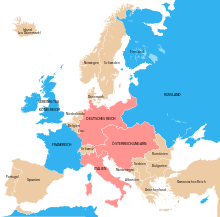
The official alliance system in 1914: Triple Alliance Triple Entente

The actual war constellation in the pre-war borders
.svg.png)
The European Alliance System around 1900 and 1910

Colonial empires in 1914
.jpg)
Language map of Austria-Hungary 1880
July crisis and the beginning of the war
→ Main article: July Crisis and Chronology of the July Crisis 1914
In the age of high imperialism, a considerable potential for conflict had accumulated in Europe. Nevertheless, the Sarajevo assassination (June 28, 1914) was not initially considered a threat to peace. In Vienna, only Chief of General Staff Franz Conrad von Hötzendorf and Finance Minister Leon Biliński - supported, however, by large sections of the press - advocated immediate mobilization against Serbia. In a conversation with Foreign Minister Leopold Berchtold on July 1, von Hötzendorf made the war conditional on the question of whether Germany would "cover our backs against Russia or not." The German Foreign Office initially wanted to avoid war between Austria and Serbia, correctly foreseeing "world war" as a consequence. Until July 4, the Foreign Office was still of the opinion that Austria should not make humiliating demands on Serbia. As far as is known, a statement by Kaiser Wilhelm II ("The Serbs must be cleared up, and soon.") on July 4 led the Foreign Office immediately to take the opposite position.
| State | Alliance | War entry |
| Austria-Hungary | Central Powers | 49140728♠28 July 1914 |
| Serbia | Entente | 49140728♠28 July 1914 |
| German Empire | Central Powers | 49140801♠01 August 1914 |
| Russian Empire | Entente | 49140801♠01 August 1914 |
| Luxembourg | Entente | 49140802♠02 August 1914 |
| France | Entente | 49140803♠03 August 1914 |
| Belgium | Entente | 49140804♠04 August 1914 |
| Great Britain | Entente | 49140804♠04 August 1914 |
| Australia | Entente | 49140804♠04 August 1914 |
| Canada | Entente | 49140804♠04 August 1914 |
| Nepal | Entente | 49140804♠04 August 1914 |
| Newfoundland | Entente | 49140804♠04 August 1914 |
| New Zealand | Entente | 49140804♠04 August 1914 |
| Montenegro | Entente | 49140809♠09 August 1914 |
| Japan | Entente | 49140823♠23 August 1914 |
| South African Union | Entente | 49140908♠08 September 1914 |
| Ottoman Empire | Central Powers | 49141029♠29 October 1914 |
| Italy | Entente | 49150525♠25 May 1915 |
| San Marino | Entente | 49150601♠01 June 1915 |
| Bulgaria | Central Powers | 49151011♠11 October 1915 |
| Portugal | Entente | 49160309♠09 March 1916 |
| Hedjas | Entente | 49160605♠05 June 1916 |
| Romania | Entente | 49160831♠31 August 1916 |
| Greece | Entente | 49161124♠24 November 1916 /29 |
| United States | Entente | 49170406♠April 06, 1917 |
| Cuba | Entente | 49170407♠07 April 1917 |
| Guatemala | Entente | 49170422♠22 April 1917 |
| Siam | Entente | 49170722♠July 22, 1917 |
| Liberia | Entente | 49170804♠04 August 1917 |
| China | Entente | 49170814♠August 14, 1917 |
| Brazil | Entente | 49171026♠26 October 1917 |
| Panama | Entente | 49171110♠10 November 1917 |
| Nicaragua | Entente | 49180506♠06 May 1918 |
| Costa Rica | Entente | 49180524♠May 24, 1918 |
| Haiti | Entente | 49180715♠July 15, 1918 |
| Honduras | Entente | 49180719♠19 July 1918 |
Accordingly, on July 5, the legation councilor in the Imperial and Royal Foreign Ministry sent to Berlin, Alexander Hoyos (Mission Hoyos), was promised support. Foreign Ministry Alexander Hoyos (Mission Hoyos) pledged support for the course of the war and generally recommended an early strike. The following day, the Imperial Chancellor handed over to Envoy Hoyos and Ambassador Szögyény the official, identical reply, which was later interpreted as a blank check issued in "extreme negligence."
According to Kurt Riezler's diary entries from the meetings with Reich Chancellor Bethmann Hollweg (July 7-8, 1914), the Reich leadership's motives were based on the consideration that a war could be won in 1914 rather than later due to Russia's growing military and transport potential. If Austria was not supported, there was a danger that it would turn to the Entente. Although the danger of world war was seen, the German Reich leadership hoped for localization and saw the situation as favorable: "If the war comes from the East, so that we therefore fight for Austria-Hungary and not East [reach]-Hungary for us, we have a chance of winning it. If the war does not come, if the Czar does not want it, or if dismayed France advises peace, we still have a chance to break up the Entente over this action.
The day after Hoyo's return (July 7), the Austro-Hungarian Council of Ministers decided to issue an unacceptable ultimatum to Serbia and to take military action if it was expected to be rejected.
From July 20 to 23, French President Raymond Poincaré and Prime Minister René Viviani visited the Russian capital of St. Petersburg and assured their hosts of their full support. There was a consensus that Serbia bore no responsibility for the killings, that the demands on Belgrade (already known in principle) were illegitimate, and that the Entente would stand firm against the Central Powers.
The opening of the July crisis in the narrower sense was the ultimatum issued by the Imperial and Royal Foreign Minister Count Berchtold to Serbia on July 23, 1914. Foreign Minister Count Berchtold issued to Serbia on July 23, 1914, with a deadline of 48 hours.
Encouraged by the results of the talks during the French government visit, the Russian Council of Ministers decided on July 24 to support Serbia and, if necessary, to initiate mobilization.
The corresponding telegram arrived in Belgrade on July 25, in time for the Serbian response to the ultimatum. The extent to which it influenced the Serbian rejection of the core points of the ultimatum is not clear. The response to Vienna was partly concessive, partly evasive. However, the participation of Austrian officials in the prosecution of suspects was flatly rejected on the grounds that it violated the Serbian constitution. Foreign Minister Nikola Pašić personally delivered the response to the Austrian legation shortly before the deadline. Ambassador Giesl skimmed the text and left immediately with the entire legation staff.
Doubts were raised in the Entente states that Austria-Hungary was the driving force behind the events; they increasingly suspected the significantly stronger Germany.
On the morning of July 28, 1914, Emperor Franz Joseph signed the declaration of war of the Austro-Hungarian Monarchy to the Kingdom of Serbia (To My Peoples!) in Bad Ischl. Prior to this, the German government had again massively urged the ally to "discuss the matter immediately" since July 25. Vienna still wanted to issue the declaration of war only after the completion of mobilization and thus around August 12. Since the attack at Temes Kubin (alleged fire raid by the Serbs on July 26) was a propaganda fabrication and a pretended reason for war (similar to the Nuremberg airplane), the "shooting war" began shortly after 2 a.m. on July 29 with the shelling of Belgrade by the inland warships S.M.S Temes, Bodrog and Számos. Partial mobilization of the Russian army took place on July 29.
On July 29, Reich Chancellor Bethmann Hollweg opened to British Ambassador Edward Goschen that Germany would attack France, breaking Belgian neutrality, and that in exchange for British neutrality, Germany offered to restore the territorial integrity of France and Belgium - but not that of their colonies - after the war.
Tsar Nicholas II approved the general mobilization of the Russian army on July 30, which was published the next morning (July 31). The German Empire then issued an ultimatum demanding the immediate withdrawal of the Russian mobilization (by 12 noon local St. Petersburg time on August 1), although it was known that it would be much slower than the German one. After the withdrawal failed to materialize, Wilhelm II issued the mobilization order on August 1 (5 p.m.) and declared war on Russia the same day (7 p.m. local St. Petersburg time). France, allied with Russia, also issued the mobilization order on August 1 (4 p.m.). On the morning of August 2, German troops occupied Luxembourg City as planned; mounted patrols entered France while war was still undeclared, killing one French and one German soldier. In the evening (8 p.m.) Belgium was requested to make a declaration within twelve hours to the effect that the Belgian army would be passive in the face of a passage of German troops; this was refused the next morning. On the evening of August 3, Germany declared war on France for alleged border violations and invented air raids ("Nuremberg plane"). On the same day, Italian Foreign Minister Antonio di San Giuliano informed German Ambassador Hans von Flotow that, in the Italian government's view, the casus foederis did not exist, since Austria and Germany were the aggressors. Already in the afternoon the Italian declaration of neutrality was made.
Also on August 3, Theobald von Bethmann Hollweg sent a letter of justification to the British government. In it, Bethmann Hollweg described the "violation of Belgium's neutrality" as the consequence of a military predicament caused by the Russian mobilization. German patrols had already crossed the Belgian border that morning; corresponding reports were available in London. The German Empire thus violated Article I of the Treaty of London of April 19, 1839, in which the major European powers had guaranteed Belgian neutrality, and endangered British security interests. In the House of Commons on the afternoon of August 3, Edward Grey described the violation of Belgian neutrality and the danger of France's defeat as incompatible with British national interests, and Parliament followed this assessment.
At 6:00 a.m. on August 4, the German ambassador in Brussels informed the Belgian government that, having rejected his proposals, the German Reich felt compelled to use force, if necessary, to enforce the measures necessary to "repel the French threat." A few hours later, German troops marched into neutral Belgium in violation of international law and without a declaration of war. That same day (August 4), British Ambassador Goschen presented German Chancellor Bethmann Hollweg with a midnight ultimatum demanding a pledge that Germany would respect Belgian neutrality in accordance with the 1839 Treaty of London. Bethmann Hollweg reproached the ambassador for Britain going to war against Germany over a "scrap of paper," which was met with indignation in London. After the expiration of the ultimatum, Great Britain was in a state of war with the empire, and its dominions followed immediately (mostly without a separate declaration of war), so that within a few days the local war had developed into a continental war and from this into the world war. Austria-Hungary declared war on Russia on August 6, thus ending the "grotesque situation in which Germany found herself at war with Russia six days earlier than the ally for whose sake she had taken up the struggle in the first place.
· 
Berlin, Unter den Linden: Announcement of the state of imminent danger of war on the afternoon of July 31, 1914 by an officer of the Alexander Guard Grenadier Regiment.
· 
Berlin population with extra, August 1914
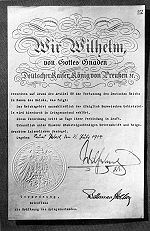
Wilhelm II decreed a state of war (announced as a state of imminent danger of war) on July 31, 1914, in accordance with Art. 68 of the Reich Constitution
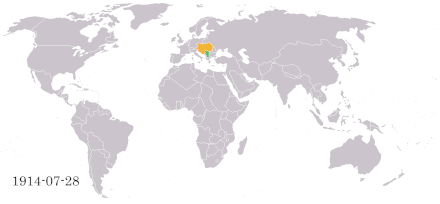
Course of the First World War
History
See also: Chronology of the First World War
War year 1914
Failure of war plans and transition to positional warfare on the Western Front
While the assembly of the German army on the western border was still in progress, the German X. Army Corps carried out a hand-strike raid on the citadel of the Belgian fortress of Liège, already planned in the Schlieffen Plan. The city quickly fell into the hands of the attackers (August 5-7), while the belt of twelve forts could not be captured at first. Only after bringing in the heaviest artillery (Krupp's Dicke Bertha and Škoda's lesser-known, more mobile Schlank Emma) was it possible to occupy the forts and completely take Liège by August 16. The climax of the fighting is considered to be the destruction of Fort Loncin on August 15 by a direct hit in the ammunition room. The rapid elimination of the forts, which were considered impregnable, led to strategic changes in further French war planning.
On August 4, the first violent attacks on civilians occurred in the Belgian villages of Visé, Berneau, and Battice near Liège. In the coming weeks, German troops committed multiple atrocities against the civilian population in Belgium and France, justifying them as attacks by franc-tireurs. The first mass shootings of Belgian civilians took place on August 5, and German troops committed particularly serious war crimes in Dinant, Tamines, Andenne, and Aarschot. Between August and October 1914, about 6,500 civilians fell victim to reprisals, and the firebombings in Louvain received particular worldwide attention and condemnation. The reception of actual and invented assaults went into the English propaganda term Rape of Belgium, still in use today.
While the German troops unfolded their bow movement over Belgium within the framework of the Schlieffen Plan, Plan XVII was prepared on the French side, which, in contrast to the German encirclement strategy, relied on the strategy of penetration in the center (Lorraine). Before the actual large-scale attack under this strategy, an advance attack was made on Mulhouse/Mulhouse. In this way, French commander Joffre aimed to tie up German troops in the south and boost the enthusiasm of the French population by advancing into Alsace, which had fallen to Germany after the defeat of 1871, and he certainly succeeded during the short-term capture of the second largest city and the most important industrial center in the region. Mulhouse was taken on August 7, with part of the population there cheering the French soldiers. As early as August 9, the German troops were back in action. After another conquest, the city and all Alsatian territories, with the exception of the Doller valley and some of the Vosges heights, fell again to the Germans on August 24 for the rest of the war. General Louis Bonneau, who commanded the French attack, was dismissed by Joffre.
Joffre initially had no intention of being influenced by the German attack on Belgium in his deployment under Plan XVII and concentrated 1.7 million French troops in five armies for the attack. However, he could not completely ignore the movement of German troops and moved the 5th Army under Charles Lanrezac accordingly farther northwest. The British Expeditionary Corps under General John French, which had just landed in France, joined north at Maubeuge. The French offensive initially began on August 14, with the 1st Army under General Auguste Dubail and the 2nd Army under General Noël de Castelnau crossing the border and advancing on Saarburg (Lorraine) and elsewhere. The German 6th and 7th Armies - both commanded at the time by Crown Prince Rupprecht of Bavaria - initially fell back fighting.
On August 18, after the defeat of the Liège fortress (final fall of Liège on August 16), the real major offensive of the German right wing to surround the Allied armies began. In the process, it advanced very quickly to Brussels and Namur. The main part of the Belgian army retreated to the fortress of Antwerp, whereupon the two-month siege of Antwerp began. On August 20, the French offensive proper began in the direction of German Lorraine and the Saar-Ruhr area, and at the same time the German counterattack began. From this and from a series of further battles near Saarburg, near Longwy, in the Ardennes, on the Meuse, between the Sambre and the Meuse and near Mons, battles between the Vosges and the Scheldt developed with heavy losses for both sides, the so-called border battles. The French troops suffered exceptionally heavy losses; between August 20 and 23, 40,000 soldiers fell, 27,000 on August 22 alone. The losses were caused mainly by machine guns. The French 1st, 2nd, 3rd, and 4th Armies were severely beaten head-on by the German 4th, 5th, 6th, and 7th Armies, as were the 5th Army and the British Expeditionary Corps on the left wing. The French troops, however, succeeded in a sufficiently orderly retreat behind the Meurthe and the ring of fortifications around Nancy, on the one hand, and behind the Meuse, on the other, while preserving the fortress of Verdun, without the German troops succeeding in encircling and completely destroying large detachments. Disregarding the Schlieffen plan, Crown Prince Rupprecht asked Chief of Staff General Moltke to take advantage of the success and go on the offensive himself, which the latter approved. However, this German offensive between August 25 and September 7 brought no breakthrough.
The French and British armies on the left wing began a general but orderly retreat through northern France, punctuated by isolated battles such as the Battle of Le Cateau (26 August) and the Battle of St. Quentin (29 August), bringing the pursuing German right wing ever closer to Paris. The French government left the capital on September 2 and moved to Bordeaux, and the defense of Paris was entrusted to the reactivated General Joseph Gallieni. The French high command, meanwhile, drew together troops from the right wing as well as reserves to raise a new (6th) army under Joseph Maunoury near Paris to threaten the German advance on the flank. Another (9th) army under Ferdinand Foch was inserted in the center. Joffre planned to use the Marne as a fallback position from which to halt the German advance with an offensive along the entire front.
The German swing wing-the 1st, 2nd, 3rd, 4th, and 5th German Armies-had already made its turn toward the southwest and south at still high speed; the 1st Army deviated southward from its planned direction of advance as early as after the capture of Brussels (August 20), as commander Alexander von Kluck pursued French troops and the British Expeditionary Corps. As the front expanded, the surprise effect of the German offensive diminished, and the numerical superiority of the German right wing was lost as it stretched; the German lines of communication became longer and longer, those of the French shorter and shorter. The dispersed German front threatened to break up by the end of August, the right wing was forced to change its line of thrust further and swing south and southeast due to counterattacks, and the encirclement of Paris was abandoned on August 30, of which Joffre was informed on September 3.
In the meantime, the Supreme Army Command stationed in Luxembourg lost track of the operational situation; above all, it lacked any telephone communication with the threatened right wing. The technically inadequate radio communications could not make up for this, and the airborne messages often went unused. The 1st Army (320,000 troops) attempted to encircle the British Expeditionary Force with forced marches, neglecting western flank protection. The surrender of two corps to the Eastern Front, siege troops left behind (Antwerp, Maubeuge), march and combat losses, and supply difficulties caused stalemates; the exhausted 1st Army had covered over 500 kilometers in heavy fighting.
On September 6, the French offensive against the open flank of the German army ("Battle of the Marne") began. The German 1st Army, which despite instructions to the contrary had still advanced south of the Marne on September 5, 1914, reaching as its westernmost points the communes of Le Plessis-Belleville, Mortefontaine and Meaux around Paris (furthest advance: ![]() 48,9732,905), was forced to retreat in a two-day forced march. By its sudden about-face, it caused a gap some 40 kilometers wide between the German 1st and 2nd Armies, into which strong French and British forces crashed about noon on September 8, 1914. The cohesion of the German front was torn, the danger of an operational breakthrough and an encirclement of the German armies grew hour by hour, there was a threat of strangulation and destruction of individual German army units, a hasty retreat, and at worst a rearward encirclement of the entire German Western Army. The German armies were at the end of their tether after their non-stop advance. Lieutenant Colonel Richard Hentsch, sent by the Oberster Heeresleitung (OHL) to the supreme command of the 1st and 2nd Armies, recommended withdrawal, which was ordered by the commanders-in-chief of the two armies on September 9, without further contact with neighboring armies or the OHL.
48,9732,905), was forced to retreat in a two-day forced march. By its sudden about-face, it caused a gap some 40 kilometers wide between the German 1st and 2nd Armies, into which strong French and British forces crashed about noon on September 8, 1914. The cohesion of the German front was torn, the danger of an operational breakthrough and an encirclement of the German armies grew hour by hour, there was a threat of strangulation and destruction of individual German army units, a hasty retreat, and at worst a rearward encirclement of the entire German Western Army. The German armies were at the end of their tether after their non-stop advance. Lieutenant Colonel Richard Hentsch, sent by the Oberster Heeresleitung (OHL) to the supreme command of the 1st and 2nd Armies, recommended withdrawal, which was ordered by the commanders-in-chief of the two armies on September 9, without further contact with neighboring armies or the OHL.
The necessity of the retreat - especially that of the 1st Army - was later disputed, but most people today hold the opinion formulated by Holger Afflerbach, for example: "Operationally, the order to retreat was correct and absolutely necessary, but its psychological effects were fatal. The Schlieffen Plan had failed, the constriction of the French army on the eastern border (Lorraine and Alsace) had failed. On September 9, Chief of Staff General Moltke saw the envelope; he wrote that day:
"Things are going badly ... The beginning of the war, which began so hopefully, will turn into the opposite [...] how different it was when we opened the campaign so gloriously a few weeks ago [...] I fear that our people in their frenzy of victory will hardly be able to bear the misfortune."
Chief of Staff General Moltke suffered a nervous breakdown and was replaced by Erich von Falkenhayn. The 1st and 2nd German Armies were forced to abandon the battle and withdraw, with the remaining assault armies following. The subsequent retreat of the German attack wing behind the Aisne resulted in the First Battle of the Aisne, which initiated the transition to positional warfare. However, the German forces were able to dig in after their retreat along the Aisne and re-establish a cohesive, resilient front. On September 17, the French counterattack came to a halt. In France, this German retreat was later dubbed the "Miracle on the Marne"; in Germany, the order drew the harshest criticism. Falkenhayn urged Reich Chancellor Bethmann Hollweg to inform the German public about the critical military situation after the failure of the attack plan, but the latter refused.
At first, Falkenhayn stuck to the previous concept, according to which the decision should first be sought in the west. In the race to the sea (September 13 to October 19, 1914), both sides tried to outflank each other, and the fronts were extended from the Aisne to Nieuwpoort on the North Sea. In northern France, the opponents tried to resume the war of movement in the first weeks of October 1914, with the German troops achieving some successes with heavy losses (capture of Lille, Ghent, Bruges and Ostend), but without achieving a breakthrough. Thereafter, the focus of the fighting shifted further north to Flanders, and the English supply via Dunkirk and Calais was to be interrupted.
On October 16, 1914, the Declaration of the University Teachers of the German Reich was published. It was signed by over 3,000 German university professors, almost the entire faculty of Germany's 53 universities and technical colleges, and justified World War I as a "defensive struggle of German culture." Foreign scholars responded a few days later in the New York Times and The Times.
Fierce fighting developed at Ypres (First Battle of Flanders from October 20 to November 18, 1914). Hastily formed German reserve corps suffered devastating losses at Langemarck and Ypres. Inadequately trained young soldiers led by reserve officers with no front-line experience - occasionally 15-year-olds - went to their deaths here by the tens of thousands without achieving any significant objective. Nevertheless, the myth of Langemarck was constructed from this - the first significant example in this war of reinterpreting military defeats or failures into moral victories. In the process, the Allies succeeded in removing the Channel ports of Boulogne and Calais, important for British supplies, and the rail junction of Amiens from German grasp.
The war of movement ended with the fighting at Ypres. An extensive system of trenches (trench warfare) emerged on the German western front. All attempts by both sides to break through failed in 1914, and a front more than 700 kilometers long from the North Sea to the Swiss border (→ Switzerland in the First World War) froze in positional warfare; at the front sections, the frontmost trenches were often barely 50 meters from the enemy positions.
On November 18, 1914, Falkenhayn opened Reich Chancellor Bethmann Hollweg that the war against the Triple Entente could no longer be won. He pleaded for a diplomatic liquidation of the war on the continent, for a negotiated and separate peace with one or more adversaries, but not with Great Britain, with which he did not consider a political settlement possible. Reich Chancellor Bethmann Hollweg rejected this. The Reich Chancellor's reasons for this were primarily domestic; in view of the great sacrifices of the attack, he did not want to forego annexations and a "victory prize" for the people. Hindenburg and Ludendorff assumed that the enemy had an unconditional will to annihilate them and also still considered a victorious peace possible. The Reich Chancellor and the General Staff concealed from the nation the significance of the defeats on the Marne and at Ypres. In this way, they kept the nation's will to fight and persevere high. The discrepancy between the political-military situation and the war aims of the economic and political elites thus widened increasingly as the war progressed, contributing to the social front during the war and beyond.
In November 1914, the British navy declared the entire North Sea a war zone and imposed a distance blockade. Ships flying the flag of neutral states could become the target of British attacks in the North Sea without warning. This action by the British government violated applicable international law, including the 1856 Declaration of Paris, to which Great Britain was a signatory.
On December 24 and the following two days, the so-called Christmas truce, an unauthorized ceasefire among soldiers, took place on some sections of the Western Front. This Christmas truce, combined with fraternization gestures, probably involved over 100,000 mainly German and British soldiers.
Fighting in the East and the Balkans
→ Main articles: East Prussian Operation (1914), Battle of Galicia and Serbian Campaign 1914.
Since, contrary to the assumptions of the Schlieffen Plan, two Russian armies entered East Prussia two weeks after the outbreak of war and thus unexpectedly early, the situation on the eastern front was initially extremely tense for the German Reich. As a result of the Schlieffen Plan, the Germans were rather defensive on their eastern front; only a few Russian-Polish border towns had been occupied, with the destruction of Kalisz. After the Battle of Gumbinnen (August 19-20), the 8th Army defending East Prussia was forced to surrender large parts of the country. As a result, troops were reinforced and the previous commanders were replaced by Major General Erich Ludendorff and Colonel General Paul von Hindenburg, who initiated the securing of East Prussia with victory at the Battle of Tannenberg from August 26-31. In the process, German troops succeeded in encircling and largely destroying the Russian 2nd Army (Narew Army) under General Alexander Samsonov. The Battle of the Masurian Lakes followed from September 6 to 15, ending with the defeat of the Russian 1st Army (Nyemen Army) under General Paul von Rennenkampff. The Russian troops then evacuated most of East Prussia.
Russian troops occupied Galicia, which belonged to Austria-Hungary, after the Battle of Galicia from August 24 to September 11. The Austro-Hungarian army had to retreat to the Carpathians in September after an advance on the Galician capital of Lviv due to overwhelming Russian superiority (Battle of Lviv 26 August to 1 September). The first siege of Przemyśl from September 24 to October 11 was repulsed. A military operation organized to relieve the k. u. k. troops by the newly formed German 9th Army launched offensive in southern Poland (from September 29 to October 31) with the aim of reaching the Vistula failed. On November 1, Colonel General von Hindenburg was appointed Commander-in-Chief East of the German Army. On November 9, the second siege of Przemyśl began, which ended fatally for Austria on March 22, 1915, and on November 11, the German counteroffensive in the Łódź area, which lasted until December 5, after which the tsarist troops switched to the defensive. From December 5 to 17, Austro-Hungarian troops succeeded in halting a Russian advance on Kraków, after which the enemy initially remained in positional warfare in wide areas of the front. In the Winter Battle of the Carpathians (December 1914 to April 1915), the Central Powers were able to hold their own against Russia.
The starting point of the war, the conflict between Austria-Hungary and Serbia, was marginalized in view of the large-scale escalation from August onward. The three offensives of the Austro-Hungarian army between August and December 1914 mostly failed or brought only partial successes; in December, Belgrade could be taken only briefly. The k. u. k. Army suffered a devastating failure in this theater of war as well. Especially the first imperial and royal offensives were accompanied by heavy attacks against the Serbian civilian population. Several thousand civilians were killed, villages plundered and burned. The Austrian army leadership partially admitted the assaults and spoke of "unorganized requisitions" and "senseless reprisals." The Serbian army was at the end of its tether after the show of force - against an opponent several times superior in resources - in December. In addition, epidemics had broken out in the country.
Entry of the Ottoman Empire into the war
German military missions to the Ottoman Empire and the construction of the Baghdad Railway had already intensified relations between the German and Ottoman Empires before the war. On August 1, there was the snubbing seizure of two battleships ordered in Britain, some of which had already been paid for. The government of the Ottoman Empire initially tried to stay out of the fighting in an "armed neutrality." The ruling Young Turks realized that they would have to lean on a major power in order to hold their own militarily. At Enver Pasha's instigation, a wartime alliance was finally formed with Germany and Austria-Hungary, which was controversial in the cabinet.
On September 27, the Dardanelles were officially closed to international shipping. After the two ships of the German Mediterranean Division under Rear Admiral Wilhelm Souchon, Goeben and Breslau, escaped the British Mediterranean Fleet and entered Constantinople, the two warships handed over to the Ottoman Fleet, still commanded by Souchon and manned by German sailors, fired on Russian coastal towns in the Black Sea on October 29. As a result, France, Britain, and Russia declared war on the Ottoman Empire in early November. On the morning of November 14, the Sheikhül Islam of the Ottoman Empire Ürgüplü Mustafa Hayri Efendi proclaimed jihad against enemy states in front of the Fatih Mosque in Constantinople, following an edict by Sultan Mehmed V. During the war, this call resonated only with individual Muslim units in British service, such as Indian Muslims from Punjab who mutinied in Singapore on February 15, 1915. The call had a reinforcing effect on anti-British sentiment in Afghanistan, which erupted after the end of the war in the Third Anglo-Afghan War.
Shortly after the declaration of war, ready British-Indian troops landed at Fao in the Persian Gulf on November 6 to protect the British oil concessions of the Anglo-Persian Oil Company, thus opening the Mesopotamian front. After several encounters with weaker Ottoman forces, they succeeded in capturing Basra as early as November 23.
Russian troops also opened the offensive on the Caucasus front in early November (Bergmann Offensive). There, an attempt to counterattack the Ottoman 3rd Army in winter resulted in its first heavy defeat at the Battle of Sarıkamış. On the Russian side, Armenian volunteer battalions took part in the fighting, which intensified sentiment against the Armenians among the Young Turk leadership, even though the majority of the ethnic group was loyal to the Ottoman Empire. Russian troops attacked from northeastern Persia, which they had occupied for some time (→ World War I in Persia). For the time being, there was no major fighting on the Palestine front.
War in the colonies
As early as August 5, 1914, the London Committee of Imperial Defence had decided to extend the war by unilaterally interpreting the treaties of the Berlin Africa Conference of 1884/85 ("Congo Conference") and to attack all German colonies or have them attacked by French, Indian, South African, Australian, New Zealand or Japanese troops. This resulted in some heavy fighting, especially in Africa. The colony of Togo, surrounded on all sides, was immediately taken. Cameroon was also difficult to hold: By the end of 1914, German troops had retreated into the hinterland. There, a grueling small-scale war developed that dragged on until 1916. The South African Union attacked German Southwest Africa, which initially held its ground at the Battle of Sandfontein from September 24 to 26. Delaying the South African Union attacks was the anti-British uprising by part of the Burian population, which was not finally put down until February 1915. German East Africa defended itself doggedly under Paul von Lettow-Vorbeck and initially forced the British troops to retreat at the Battle of Tanga (November 2-4, 1914). Thanks to the German strategy of retreats and guerrilla tactics, the Schutztruppe für Deutsch-Ostafrika was able to hold out until the end of the war. The German colonies in the Pacific, where no Schutztruppen were stationed, were handed over to Japan, Australia and New Zealand almost without a fight. The German colony of Kiautschou was fiercely defended during the siege of Tsingtau until material and ammunition were exhausted (surrender November 7, 1914).
See also: World War I outside Europe
War year 1915
Submarine warfare
On February 4, the German Reich made the official announcement of submarine warfare against merchant ships on February 18. The waters around Great Britain and Ireland were declared a war zone against the protest of neutral states, although there were not enough submarines available to effectively blockade Great Britain. By using U-boats against merchant ships, Germany broke new ground both militarily and under international law. U-boats could only imperfectly comply with the rules of the Prisenrecht, especially since the increasing armament of British merchant ships endangered the safety of the boats. In addition, submarine commanders were not given clear instructions for execution. The naval leadership evidently assumed that most sinkings would be made without warning and that a deterrent would thereby be achieved vis-à-vis neutral shipping. However, due to protests from neutral countries following the German announcement, U-boat warfare was formally restricted in that no neutral ships were to be attacked.
On May 7, the German submarine U 20 sank the British passenger ship Lusitania, which triggered a wave of protest, especially in the United States. This was because over 200 U.S. citizens were on board the Lusitania when it left the port of New York on May 1, 1915, even though the German embassy in Washington had issued advertisements warning against using British ships to cross to the United Kingdom. For Americans, the sinking of the Lusitania and the deaths of the many Americans came as a shock that made you realize how difficult it was to stay out of the world war. When the passenger liner was sunk on May 7, 1198 passengers and crew members died, including nearly 100 children and 127 U.S. citizens. There was outrage in America, and an exchange of notes between the American and German governments followed. On June 1 and 6, the Kaiser agreed to the Reich Chancellor's request (at the time still supported by the OHL on this issue) that German submarines should not sink neutral ships and, in general, large passenger steamers. Grand Admiral Tirpitz and Admiral Gustav Bachmann immediately submitted resignation petitions for this reason, which the Kaiser rejected in curt terms. After the sinking of the steamer Arabic on August 19, 1915, by U 24, in which Americans were again killed, Ambassador Johann Heinrich von Bernstorff made clear the restrictions now imposed by the American government (Arabic pledge). The German press was informed at the end of August and its chief editors - explicitly Ernst Graf zu Reventlow, but also Georg Bernhard - were instructed by the General Staff to immediately cease the campaigns conducted by some newspapers for unlimited submarine warfare and against the U.S. (based on their notes).
Germany seeks war decision on the Eastern Front
On the Eastern Front, the German army, with the help of the newly arrived 10th Army, defeated the Russians in the Winter Battle of Masuria from February 2 to 27. The Russian troops then withdrew from East Prussia for good.
In November 1914, Paul von Hindenburg and Erich von Ludendorff, as his Chief of Staff, had been given supreme command of all German forces on the Eastern Front and since then had successfully worked to try to win the war in the East in 1915. The goal of the German leadership was to prepare to blow up the opposing coalition by weakening Russia. Since the general situation in the east - almost all of Galicia was Russian-occupied - made a separate peace move on the part of the Central Powers seem unpromising for the time being, military means were to be used to increase pressure on Russia and also to make a favorable impression on the neutral states, especially in the Balkans. Above all, the expected entry of Italy into the war threatened a dangerous strategic situation for Austria-Hungary: the Russians had been able to hold their own in the Carpathian Mountains during the Winter Battle, but if Italy had entered the war, a large-scale pincer movement (between the Isonzo and the Carpathians) could have meant the military end of the Danube monarchy. A breakthrough in western Galicia up to the San was to force the Russian formations to retreat from the mountains, otherwise they would have to fear encirclement on their part. For this purpose, parts of the Western Army (the 11th Army under August von Mackensen) were transferred to the Eastern Front in the spring of 1915. From May 1 to 10, the Battle of Gorlice-Tarnów took place east of Kraków, in the course of which the German and Austro-Hungarian troops (4th Army) succeeded in making an unexpectedly deep penetration of the Russian positions, reaching the San by mid-May. The battle marked a turning point on the Eastern Front. The success could not hide the fact that Austria-Hungary had to bear losses of nearly 2 million men from the beginning of the war until March 1915 and was increasingly dependent on massive German aid.
In late June, the Central Powers continued their attack with the Bug Offensive. After the recapture of Przemyśl on June 4 and Lemberg on June 22, the strangulation of the front arc in Russian Poland seemed within reach; with coordinated attacks from the north and south, the Russian formations were to be encircled there, and the Supreme Army Command - with such success in mind - postponed attacks on other fronts. However, this planning by Ludendorff seemed too ambitious to Falkenhayn and Mackensen - in view of the experience in the Battle of Marne - and was scaled down accordingly. The Bug Offensive (June 29-September 30) and the Narew Offensive (July 13-August 24) did not result in the encirclement of large bodies of troops, but the Russian army was forced into a "Great Retreat." Evacuation of Poland, Lithuania, and large parts of Courland and shortening of the Russian front from 1600 to 1000 kilometers. By September, the Central Powers succeeded in capturing important cities such as Warsaw (August 4), Brest-Litovsk and Vilnius. In Russian Poland, the occupying powers created two general governorates: an Austrian one in Lublin and a German one based in Warsaw. In "Upper East," de facto a military state in the territories under German supreme command other than Russian Poland, an occupation policy was subsequently pursued for the intensive economic exploitation of the country and its human resources. Toward the end of September, further offensives by the 10th Army under Ludendorff against Minsk and by Austrian troops against Rovno failed. Despite the Russian army's higher overall losses, it continued to outnumber the Germans after the conclusion of the Great Retreat (September 1915), and the planned redeployment of large parts of the German forces to the Western Front could not take place to the extent hoped for.
The Western Front 1915
On the Western Front, the Allies initially pursued the classic strategy of cutting off the great German frontal arc between Lille in the north and Verdun in the south by pressing both flanks and, if possible, interrupting the rail lines that were important for supplies. This strategy initially led to the Winter Battle in Champagne (until the end of March), which had already been prepared at the end of 1914 and in which the type of material battle emerged: days of artillery fire escalating to a barrage intended to massively demoralize and wear out the enemy, followed by the massive infantry assault. However, this tactic did not succeed, as the Germans were prepared for the attack by the shelling and were able to repel it with barrage and machine gun fire due to structural advantages of the defender in trench warfare from the well-developed dugouts. Allied attacks on the small, strategically threatening frontal arc of Saint-Mihiel (Easter Battle or First Woëvre Battle between Meuse and Moselle) also failed.
The use of poison gas on the first day of the Second Battle of Flanders, April 22, is considered a "new chapter in the history of warfare" and the "birth of modern weapons of mass destruction." Although irritants had also been used by the Allies before in the gas warfare during World War I, since lethal chlorine gas was used on April 22, the attack was internationally considered a clear violation of the Hague Land Warfare Regulations and was exploited accordingly for propaganda purposes. The gas attack was carried out using Haber's blowing method, which depended on the wind direction. As early as March, sappers installed concealed gas cylinders in the front trenches near Ypres, from which the gas was to be blown off. Since easterly winds are relatively rare in West Flanders, the attack had to be postponed several times. On April 22, a steady north wind blew, and accordingly the gas was blown off the northern part of the Allied front arc around Ypres. The effect was much more serious than expected: The French 87th as well as the 45th (Algerian) Division fled in panic, opening a six-kilometer-wide gap in the Allied front. The death toll from this gas attack was contemporarily put at up to 5000; today's estimates are around 1200 dead and 3000 wounded. The German leadership had not expected such an effect and probably for that reason did not provide sufficient reserves for a further advance, apart from that the gas impaired the attackers. The frontal arc of Ypres was merely reduced in size during the Second Battle of Flanders and could be held by the British troops and the newly arrived Canadian division at the front. Due to the use of gas, casualties among the defenders were significantly higher than among the attackers (about 70,000 to 35,000), which was unusual for trench warfare in the First World War.
On May 9, the British and French attempted a breakthrough in Artois in the Battle of Loretto. Despite enormous losses (111,000 Allied and 75,000 German soldiers), this produced only partial successes and was broken off in mid-June. On the German side, tactical changes increasingly succeeded in further expanding the defender's structural advantages in trench warfare: While traditionally the defense had been concentrated on a first line in a forward slope position (best overview and wide field of fire), the German troops increasingly switched to shifting the focus of the defense to the second line in a rear slope position due to the Allies' material superiority. On the one hand, this gave the Allies enough time to bring up reserves during the breakthrough; on the other hand, the superior Allied artillery was no longer accurate enough to eliminate the German positions due to the lack of a direct line of sight.
The last major combat operations on the Western Front of the 1915 war year were Allied offensives between September 22 and October 14, again in Artois and Champagne. The Autumn Battle of Champagne and the Autumn Battle of La Bassée and Arras produced hardly any results, with heavy losses and successively increasing use of materiel: "The Entente troops had to pay for minimal gains in terrain with losses of up to a quarter of a million men."
The Gallipoli Operation of the Allies
→ Main article: Battle of Gallipoli
On February 19, the Allied Dardanelles Operation began with the shelling of Turkish coastal forts along the Dardanelles by British and French warships. Initially, minesweepers attempted to clear Turkish mine barriers in the strait in order to reach the objective of Constantinople directly. The Allies' intention was to push the Ottoman Empire out of the war by threatening its capital and to open the supply route to Russia through the Dardanelles. On March 18, a breakthrough attempt was made by naval forces under Admiral John de Robeck, sinking three Allied battleships and damaging others. As a result, the Allied governments decided to force the opening of the Dardanelles by landing ground troops. Previously, British military forces had considered troop landings at Alexandretta to separate the southern areas of the Ottoman Empire from the Anatolian heartland.
On April 25, the Allied landings began on the Gallipoli Peninsula and on the opposite Asian coast at Kum Kale. Allied troops had previously occupied the island of Limnos, among others, in defiance of Greek neutrality, in order to use it as a base for attacks against the Ottoman Empire. 200 merchant ships-covered by 11 warships-deployed 78,000 British troops of the Mediterranean Expeditionary Force and 17,000 French troops of the Corps expéditionnaire d'Orient, including the Australian and New Zealand Army Corps (ANZAC) in its first wartime deployment. The attack failed due to unexpectedly fierce Turkish resistance, with Mustafa Kemal in particular standing out as commander of the 19th Division in the 5th Ottoman Army under the overall command of Otto Liman von Sanders, laying the foundation for his reputation as a popular hero. The operation, in which a total of over 500,000 Allied soldiers were engaged, had to be called off by January 9, 1916, with a full-scale amphibious evacuation. In the battle, 110,000 soldiers from both sides lost their lives.
Italy's entry into the war
On May 23, Italy declared war on Austria-Hungary. Since January, Germany had been pressuring Austria to cede Trentino and other territories to Italy in order to at least guarantee its neutrality. Even after the denunciation of the Triple Alliance on May 4, more and more extensive offers were made to Italy, including on May 10 the cession of Trentino and the Isonzo region, a largely free hand in Albania, and more. On the other hand, Italy had negotiated with the Allies and, in the London Treaty of April 26, had obtained more far-reaching promises in the event of the Allies entering the war. Prime Minister Antonio Salandra and Foreign Minister Sidney Sonnino had decided, after months of tactics, to declare war on Austria with the express approval of King Victor Emmanuel III. In doing so, they followed the pressure of public opinion, although there was no majority in favor of war among the population or in Parliament at the time of the declaration. The supporters of the war against Austria were far more active and were able to unite the most important Italian opinion leaders from all political directions. Political irredentism, for example, was able to draw on Cesare Battisti. Gabriele D'Annunzio - writer and later pioneer of European fascism - organized public events and mass demonstrations for the war in Rome, while the socialist publicist Benito Mussolini had been advocating the war since October 1914, which led to his expulsion from the Partito Socialista Italiano. Mussolini then founded his own newspaper, Il Popolo d'Italia, presumably financed by France, with which he continued to call for Italy to enter the war on the side of the Entente. The war supporters received further public support from the Futurists around Filippo Tommaso Marinetti. Although the parliament supported the neutrality course of majority leader and previous prime minister Giovanni Giolitti shortly before the declaration of war, which earned him calls for assassination from D'Annunzio, the parliament was not the real locus of political decision-making. When it was convened on May 20 on the occasion of the approval of the war credits, only the Socialists voted against the credits, while the former opponents of the war, such as the Giolitti supporters and the Catholics, sought to prove their patriotic attitude by accepting the war credits.
The Italian front ran from the Stelvio Pass on the Swiss border through Tyrol along the Dolomites, the Carnic Alps and the Isonzo to the coast of the Adriatic Sea. As a result, Austria-Hungary was immediately in a three-front war, which complicated the situation for the Central Powers. In addition, the Austrians were not able to secure parts of the Italian front sufficiently at the beginning of the fighting; in many cases only local militias, Landwehr and Landsturm were used, including 30,000 Standschützen. The fighting on the Isonzo began immediately after the declaration of war, the actual start of the First Battle of the Isonzo being set for June 23. Despite great superiority and territorial gains, the Italians failed to make a decisive breakthrough either in this battle (until July 7) or in the Second Isonzo Battle that immediately followed (July 17-August 3). This was also true of the Third and Fourth Isonzo Battles; high losses in men and materiel were accompanied by no changes in the overall strategic picture. The First Dolomite Offensive (July 5-August 4), which marked the beginning of the Alpine War, also fit into this picture and constituted another novelty in military history: Never before had there been prolonged combat operations in the high mountains, which took place up to a sea level of 3900 meters (Ortlerstellung).
Armenian Genocide
Since the Battle of Sarıkamış, the Young Turk leadership increasingly suspected Armenians of sabotage. When the Russians approached Lake Van in mid-April, five local Armenian leaders were executed in this region. This and other incidents led to unrest in Van. On April 24, a wave of arrests of Armenian intellectuals began in Constantinople (now a national day of remembrance in Armenia). On May 24, Russian Foreign Minister Sasonov issued an international protest note (prepared as early as April 27) claiming that the population of more than 100 Armenian villages had been massacred, and that representatives of the Turkish government had coordinated the killings. The following day (May 25), Ottoman Interior Minister Talât Pasha announced that Armenians would be deported from the war zone to Syria and Mosul. On May 27 and on May 30, the government of the Ottoman Empire issued a deportation law, beginning the systematic phase of the Armenian genocide and the Assyrian genocide. German Ambassador Hans von Wangenheim reported to Chancellor Bethmann Hollweg as early as June of Talât Pasha's view that "the Porte wanted to use the world war to thoroughly clean up its internal enemies - the local Christians - without being disturbed by the diplomatic intervention of foreign countries." Max Erwin von Scheubner-Richter, German vice-consul in Erzerum, also reported in late July "that the ultimate goal [of the] action against the Armenians was the complete extermination of them in Turkey." In December 1915, the German ambassador and Wangenheim's successor, Paul Metternich, tried to intervene with the Turkish government in favor of the Armenians and suggested that the German government make the deportations and outrages public. However, this was not approved by Reich Chancellor Bethmann Hollweg, who noted instead: "The proposed public coramation of a confederate during the ongoing war would be a measure unprecedented in history. Our only aim is to keep Turkey at our side until the end of the war, whether Armenians perish over it or not." Even an intervention by Pope Benedict XV, who wrote directly to Mohammed V, the Sultan of the Ottoman Empire, came too late. The genocide claimed an estimated one million lives by the end of the war and was contemporarily referred to as the "Holocaust" even in its precursors (the massacres and pogroms of 1895/96 and the massacre of Adana in 1909).
Bulgaria's entry into the war and the Central Powers' campaign in Serbia
The Central Powers were reinforced by Bulgaria's entry into the war on October 14, 1915. In the Balkan Wars, Bulgaria had not been able to assert its territorial claims for the creation of an "ethnic Bulgaria"; practically all conquests made in the First Balkan War had to be surrendered again in the Peace of Bucharest in 1913, and the country was also considerably weakened by the wars. Thus, on August 1, 1914, the government of Vasil Radoslavov initially declared Bulgaria's strict neutrality. The Central Powers and the Allies subsequently made efforts to persuade Bulgaria, which in turn could make its participation in the war dependent on the respective offer. In this respect, the Central Powers were in the better starting position; they could more easily accommodate territorial interests at the expense of Serbia and, if necessary, Romania and Greece (whose entry into the war was expected on the Allied side) than the Allies; thus, the Bulgarians were promised Macedonia, Dobruja and Eastern Thrace. Accordingly, and due to the relatively favorable course of the war in the fall of 1915, Bulgaria gave the go-ahead to the Central Powers. As early as September 6, Bulgaria had agreed to cooperate with the Central Powers, who wanted to establish a land link with the Ottoman Empire by attacking Serbia. Participation in the war was extremely controversial in Bulgaria; after the government's decision to enter the war, the opposition parties - with the exception of parts of the Social Democrats - went along with the war course. On October 6, under the command of Mackensen, the Central Powers began their offensive against Serbia, and on October 14 Bulgaria declared war on Serbia. Thus the Serbs faced a considerable superiority, which the Allies could not counterbalance with a landing of troops north of Thessaloniki. Greece refused to enter the war on the side of Serbia, citing insufficient Allied support, although it had pledged to support Serbia in a bilateral treaty on June 1, 1913. After the fall of Belgrade (October 9) and Niš (November 5), the remnants of the Serbian army (about 150,000 men; at the start of the war, 360,000 men) led by Radomir Putnik withdrew to the Albanian and Montenegrin mountains with about 20,000 prisoners of war; it later returned to action on the Saloniki front after being regrouped on Corfu. Occupied Serbia was divided between Austria-Hungary and Bulgaria.
Other secondary fronts in 1915
The Battle of Sarıkamış on the Caucasus Front ended in a heavy defeat for the Ottoman Empire on January 5, 1915. On the Palestine Front, Ottoman troops under Friedrich Freiherr Kreß von Kressenstein undertook an unsuccessful offensive against the Suez Canal starting in late January.
The surrender of the German Schutztruppe in July 1915 ended the fighting in southwest Africa.
At the end of November, the British advance on the Mesopotamian front (now Iraqi territory) was halted by the Ottoman army under the de facto command of Colmar Freiherr von der Goltz at the Battle of Ctesiphon (November 22-25), and the expeditionary corps of the British Indian Army was trapped in Kut on December 7 (→ Siege of Kut).
Political and social developments
Joseph Joffre, commander-in-chief of all French troops since early December, convened a conference of the Allies from December 6 to 8 in Chantilly, where the Grand Quartier Général had been based since October 1914. To deprive the Central Powers of the advantages of the "Inner Line," coordinated attacks on all fronts were arranged for mid-1916. The British government under Herbert Henry Asquith had to be reshuffled in May of that year to include the hitherto opposition Conservatives because of the unfavorable war situation, especially at the Dardanelles. The coalition government under Asquith included a Ministry of Munitions in response to the munitions crisis of the spring of 1915.
In October and November, in view of the tightened food restrictions, there were initially riots in front of grocery stores, distribution points and free benches in Germany, but increasingly also protest gatherings of very predominantly female demonstrators. On November 30, 58 women were arrested at a protest meeting on Unter den Linden in Berlin; the press was not allowed to report on it. Prices for grain, bread, butter and potatoes had already risen sharply in November 1914, and at this point farmers were reluctant to supply the city markets, if at all. The reasons for the supply problems lay in the organizational inability of the authorities - no one had expected and prepared for a long war - as well as in the loss of food and saltpeter imports (the latter for fertilizer production); in addition, the war deprived agriculture of horses and labor. The Federal Council set maximum prices for bread, potatoes and sugar at the end of 1914, followed by other staple foods in January 1915, so that farmers increasingly tried to market their goods in "surreptitious trade." At the end of 1915, one observer noted: "The inflation has taken on a threatening character [...] The change of mood in the last few weeks, since the beginning of the stricter food restrictions, is very strong. Especially the women are becoming rabid [...] the women are shouting 'give us food!' and 'we want our men'". With the black market flourishing, the population believed less and less the official propaganda that the English naval blockade alone was responsible for the poor food supply. The consequence of the state's inability to deal with the food question was a gradual "alienation of the citizens from the state, indeed an actual 'delegitimization' of the state," beginning at the end of 1915 at the latest.
On November 27, the Reichstag parliamentary group and the party executive of the SPD decided to submit a "peace interpellation" to the Reichstag asking when and under what conditions Reich Chancellor Bethmann Hollweg intended to initiate peace negotiations. Bethmann Hollweg unsuccessfully sought to have the interpellation withdrawn, and on December 9 it was considered in the Reichstag. The Reich Chancellor answered Philipp Scheidemann's question insofar as "safeguards" (annexations) in East and West were indispensable for peace; abroad, this was interpreted as "hegemony talk". As a result, 20 Social Democratic deputies in the Reichstag session of December 21 rejected the renewed approval of war credits and issued a statement according to which Bethmann Hollweg favored "annexationists.
War year 1916
Occupation of Montenegro and Albania
Austrian troops attacked the Kingdom of Montenegro on January 4, and King Nikola surrendered on January 23 and went into exile in France (→ Campaign in Montenegro and Austro-Hungarian Occupation of Montenegro 1916-1918). The principality of Albania was also about two-thirds occupied by the Austro-Hungarian army (→ Austro-Hungarian Occupation of Albania 1916-1918). The Serbian troops that had fled to Montenegro and Albania largely retreated to Durrës, where an Italian expeditionary corps had landed in December 1915. In March 1916, the Italians evacuated 260,000 people from this port. Among them were 140,000 Serbian soldiers, who were embarked on the island of Corfu, which had been annexed by the French earlier, and reorganized militarily there (in June, they were transferred to the Orient Army in Thessaloniki); the Serbian government-in-exile, headed by Nikola Pašić, set up its headquarters on Corfu. Among those evacuated from Durrës were 24,000 Austrian prisoners of war, who were taken to the Sardinian island of Asinara, where about 5,000 died. In Albania, the Italians were able to hold the port city of Vlora, thus expanding their area of power in southern Albania. In Montenegro, Viktor Weber Edler von Webenau was military governor-general from February 26, 1916, to July 10, 1917. In Albania, which was not an active participant in the war, a civilian administrative council was established under the chairmanship of Consul General August Ritter von Kral. Through the participation of Albanian leaders and the development of schools and infrastructure, the occupying power attempted to win over the Albanians.
Battle of Verdun
On February 21, the Battle of Verdun began. Contrary to later accounts by Erich von Falkenhayn, adopted by many authors, the original intention of the attack was not to let the French army "bleed itself dry" without spatial objectives. Falkenhayn, with this assertion made in 1920, attempted to retroactively give ostensible meaning to the failed attack and the negative German myth of the "blood mill." Originally, the idea of the attack at Verdun came from Crown Prince Wilhelm, Commander-in-Chief of the 5th Army, with Konstantin Schmidt von Knobelsdorf, Chief of Staff of the 5th Army, leading the charge. The German army command decided to attack the fortress of France, which had been partially disarmed since 1915 and was originally the strongest, in order to, in turn, get the war on the Western Front moving again. Around Verdun, moreover, there was an indentation in the front between the frontal arc of St. Mihiel in the east and Varennes in the west, threatening the German front there in its flanks. Capture of the town itself was not the primary objective of the operation, but rather the heights of the east bank of the Meuse River, so as to put his own artillery in a commanding position, analogous to the siege of Port Arthur, and thus make Verdun untenable. Falkenhayn believed that France could be induced, for reasons of national prestige, to accept unjustifiable losses in defense of Verdun. In order to hold Verdun, if the plan had succeeded, it would have been necessary to recapture the heights occupied by German artillery, which was considered almost impossible in view of the experience gained in the battles of 1915.
In the first phase, after eight hours of barrage from 1500 gun barrels, eight German divisions of the 5th Army attacked over a width of 13 kilometers at Ornes (now a deserted village) to the north of Verdun. Contrary to German expectations, the French put up fierce resistance, and terrain gains were initially almost nonexistent. On February 25, Fort Douaumont was captured by German troops, which had little tactical significance due to the eastern orientation of this fortress. On the occasion of the loss of the fort, the French decided that the fortress of Verdun should be held at all costs. General Pétain was charged with the defense of the city. The only road connecting Bar-le-Duc to Verdun (stylized as the "Voie Sacrée") was used to build up the so-called Noria - supplies were brought in via this road at great expense. The battle proceeded in four phases: The first ended on March 4, as French artillery fire from the heights west of the Meuse stalled the German advance.
In the second phase, Falkenhayn gave in to the urging of the 5th Army and ordered attacks on these heights. The height "Le Mort Homme" ("Dead Man") was taken several times, but not held for very long. Le Mort Homme and Hill 304 are considered symbols of the "Hell of Verdun" because of the brutally fought battles; Le Mort Homme lost six meters in height due to the shelling.
In a third phase, the attackers again focused on capturing Verdun itself. Early in the morning of June 7, Fort Vaux surrendered for lack of water; on June 23, 78,000 men began an attack on the Vaux-Fleury line that also stalled. Briefly, German troops managed to push beyond it in a fourth phase by July 11; fierce fighting broke out around the Ouvrage de Thiaumont (immediately southwest of Douaumont). At Fort de Souville (about five kilometers northeast of Verdun) and in front of the Ouvrage de Froideterre, the German attack finally stalled; Falkenhayn, in view of this and mindful of the Allied attack on the Somme that had begun on July 1, ordered a halt to the offensive on the afternoon of July 12.
Resignation of Tirpitz and Skagerrak Battle
At the beginning of 1916, the German leadership again discussed the question of intensified submarine warfare against Great Britain. After the elimination of Serbia, Falkenhayn thought the moment had come to take more active action against Great Britain, flanking the Verdun offensive and accepting a break with the United States. He was encouraged in this by assurances from Henning von Holtzendorff, the Admiral's Chief of Staff, that Great Britain could be brought to its knees within a year. In negotiations, the Reich Chancellor obtained a postponement of the decision by the Kaiser and a provisional compromise: intensification of submarine warfare (including the sinking of armed merchant ships without warning), but no return to unrestricted submarine warfare.
In early March, a campaign initiated by the Reichsmarineamt and carried out by sections of the press in favor of unrestricted submarine warfare ("Better war with America than starvation") began, but it seriously angered the Kaiser ("His Majesty sees in this an unheard-of procedure which in the last place exposes the person of the Kaiser as the supreme head of Reich policy and warfare before the whole people"), so that Alfred von Tirpitz had to resign from his post on March 15. The intensification of submarine warfare was reversed as early as April after the Sussex incident.
On May 31 and June 1, the Battle of Jutland (Skagerrakschlacht) took place rather unintentionally, resulting in the "largest naval battle in world history" in terms of the tonnage of the ships involved (about 1.8 million tons displacement). More than 8600 sailors died, including the writer Gorch Fock. The German High Seas Fleet escaped annihilation by the British superiority with luck and tactical skill and was able to inflict significantly higher losses on the British than vice versa. However, this did not change the strategic situation and only confirmed British naval supremacy.
Brussilov Offensive and Battle of the Somme
In accordance with the agreement at the Chantilly Conference, three major Allied offensives were planned for mid-1916: The Somme attack, the Brussilov offensive, and another Isonzo battle. The attack on the Somme on July 1 was originally planned to be French-led, but because of the Battle of Verdun, it was largely taken over by the British. On the Italian front, the 6th Isonzo Battle did not begin until August 4, because, due to the German attack on Verdun, an attack (5th Isonzo Battle) had already taken place on March 11 at the request of the Allies, and the Austrians had opened the South Tyrol Offensive (until June 18) on May 15, because of which the Brussilov Offensive was brought forward and began as early as June 4.
The Brussilov Offensive, the most successful Allied large-scale attack to date, began on June 4. Alexei Brussilov, the new commander-in-chief of the Russian Southern Army since March, had drawn tactical conclusions from previous failures: the attack was launched on a broad front (400 kilometers as the crow flies), in contrast to the previous approach, so that the enemy could not concentrate troops at a predictable decisive point; the attacking infantry was protected by deep dugouts driven up to 50 meters to the enemy lines (previously, attacks over up to 1600 meters of no-man's land had been common, resulting in considerable losses). Although Brussilov's numerical superiority was not great (too small for an attack), by June 8 east of Kowel the 8th Russian Army had almost completely crushed the 4th Imperial and Royal Army. Army almost completely, the 9th Russian Army routed the 7th Imperial and Royal Army in the south between the Dniester and the Carpathians. Army and captured important cities such as Czernowitz and Kolomea. The losses for Austria-Hungary amounted to 624,000 men. Brussilov was able to advance far (up to 120 kilometers), especially near the Romanian border, which tipped the scales in Romania to enter the war on the Allied side. Logistical problems, however, prevented an even further advance; moreover, supporting attacks on the old pattern (on a narrow section of the front) in the area of the Pripyets Marshes and at Baranavichy failed, as did the attempt to capture the Kovel transport hub. "Nevertheless, the Brussilov offensive - by the standards of World War I, in which every meter of ground was fought for - was the greatest victory won by the Allies on any front since the war of position had begun on the Aisne."
The BEF, under the command of Douglas Haig, took the lead in the attack on the Somme, since the Battle of Verdun had reduced the French contingent from 40 to 11 divisions. After eight days of uninterrupted artillery preparation by over 1500 guns, during which about one and a half million shells were fired, the attack on the German positions on the Somme began on July 1, 1916. Despite the heavy gunfire, many German dugouts had remained intact, allowing German soldiers to counter the British attack with machine gun fire. On the first day of the Battle of the Somme alone, 19,240 British soldiers died, 8,000 of them in the first half hour. Despite the enormous losses, Haig allowed the offensive to continue. On September 15, the British used tanks for the first time in the history of the war. The fighting continued until November 25, and the Allies were able to push in the German front by 8 to 10 kilometers at the focal point of the attack front, which was about 30 kilometers wide (as the crow flies). British and French casualties for this modest terrain gain were 624,000 men; on the German side, losses were 420,000 men. The figures for German casualties are disputed; British authors extrapolate the number of lightly wounded - allegedly not recorded equally by the German medical report (loss figure there: 335,688) as in the corresponding Allied reports - and arrive at German losses of up to 650,000 men. In any case, the Battle of the Somme was the single most costly battle of the First World War. July 1, as the start of the battle, still has some significance in Britain today as a day of remembrance. The British historian John Keegan still summed up in 1998: "For the British, the Battle of the Somme meant their greatest military tragedy in the 20th century, indeed in their history at all [...]. For Britain, the Somme marked the end of an era of life-giving optimism to which it has never returned." The revelation of the extent of the Somme losses in late 1916 was instrumental in the change in British government leadership in December from Herbert Henry Asquith to David Lloyd George.
South Tyrol Offensive and Isonzo Battles
From May to June, the Austro-Hungarian Army conducted an offensive in South Tyrol against the Italian positions, which, after minor initial successes, had to be broken off due to the situation on the Eastern Front (Brussilov Offensive). The Italian army undertook several major attacks on the Isonzo River from March to November (5th, 6th, 7th 8th and 9th Isonzo Battles). In the process, the Italians captured the town of Gorizia and the plateau of Doberdò, but further successes of the Italian army failed to materialize. On August 28, 1916, Italy also declared war on the German Empire. Already from May to November 1915, a reinforced German division (Alpine Corps) had been moved to the front in South Tyrol to support the Austro-Hungarian ally, as the OHL considered South Germany endangered. During the mountain warfare in the Southern Alps, dozens of avalanches killed a total of several thousand Italian and Austro-Hungarian soldiers on December 13, 1916. The avalanche disaster of December 13, 1916 is considered one of the worst weather-related disasters in Europe.
Romania's entry into the war
On August 27, 1916, Romania declared war on Austria-Hungary and had in fact opened the Romanian theater of war a few days earlier. Romania had joined the Triple Alliance in 1883, but at the beginning of the war, Romania remained neutral in a literal interpretation of the treaty of alliance. Domestically, Romania was initially divided; the liberals under Prime Minister Ion Brătianu favored rapprochement with the Entente, while the majority of conservatives favored neutrality. Among the few politicians who advocated entering the war on the side of the Central Powers was King Charles I. Russia had already assured Romania of support for its territorial claims in Transylvania in an agreement of October 1, 1914. Since Romania had received southern Dobruja, inhabited by a majority of Bulgarians and Turks, in the Peace of Bucharest after the Second Balkan War, Bulgarian entry into the war on the side of the Central Powers was another factor moving Romania toward the Entente. Moreover, the "Great Romanian Unification" in the form of the inclusion of the territories of Transylvania, Banat and Bukovina, which belonged to Austria, could only be achieved in the case of a wartime alliance against Vienna. The Entente also made corresponding territorial advances (without wanting to fulfill them completely), so that Romania joined the Entente by treaty on August 17, 1916, also in view of the successes of the Brussilov offensive (see also War aims). Initially, the numerically vastly superior but poorly equipped Romanian army was able to make an extensive incursion into Hungary in Transylvania. The 9th German Army, under the command of former OHL chief Falkenhayn, defeated the Romanians at the Battle of Sibiu (September 26-29). In a large-scale house-to-house battle - rather uncharacteristic of World War I - Kronstadt was recaptured by October 8. The Central Powers set up a classic pincer movement: On November 23, Bulgarian, Turkish and German troops ("Danube Army") crossed the Danube from the southwest. Bucharest, bombed several times by airships and battle planes, was captured on December 6. Romania's entry into the war brought advantages to the Central Powers, as they were able to take over the Ploiești oil fields and large agricultural capacities during 1916, which at first noticeably alleviated supply shortages in Germany. With Russian help, the Romanians were able to hold only the northeast of their country, and King Ferdinand moved the government to Iași.
Dismissal of Falkenhayn and 3rd OHL
During the severe crisis into which German warfare was plunged by the Entente's all-front war in the summer of 1916, Kaiser Wilhelm was increasingly pressed to finally part company with Chief of Staff General Erich von Falkenhayn. Romania's entry into the war on August 27 provided the occasion. The new leadership (as of 29 August) with Paul von Hindenburg and his chief of staff Erich Ludendorff, also known as the 3rd OHL, called off offensive actions against Verdun and immediately initiated measures to increase economic mobilization; thus, on 31 August, corresponding demands, later known as the Hindenburg Program, were presented to the Prussian War Ministry. The appointment of the 3rd OHL, however, also meant a political turning point that led to a de facto military dictatorship: "With the appointment of the military duo Hindenburg/Ludendorff, whose nimbus made them virtually irremovable, the monarch not only moved further into the background than before in the war, but also fell into the political maelstrom of the OHL. [...] The indispensable general duo [...] was [...] ready to intervene in politics far beyond military competencies, to put the emperor under pressure and even to exert decisive influence on the selection of personnel - the center of imperial power."
French counterattack at Verdun and replacement of Joffre
In the fall, the French army went on a counteroffensive at Verdun. On October 24, French troops captured Forts Douaumont and Thiaumont. Further French offensives forced the Germans to evacuate Fort Vaux on December 2. The fort was blown up by German sappers after it was cleared. By December 16, the French had recaptured almost all the territory the Germans had taken in their spring offensive.
The battle of Verdun resulted in 337,000 German casualties (including 143,000 dead) and 377,000 French casualties (162,000 dead). At least 36 million shells had fallen on the battlefield, which was about 30 kilometers wide and 10 kilometers deep.
As the French commander-in-chief Joseph Joffre was blamed for misjudging the German intention to attack at Verdun as well as for the equally bloody and useless offensives in Champagne and on the Somme, he came under increasing criticism. On December 3, he was replaced by General Robert Nivelle (1856-1924), who had led the successful counteroffensive at Verdun and thus recommended himself for leadership of the Allied spring offensive planned for the following year. Nivelle was thus initially preferred to Philippe Pétain, the successful defender and "hero of Verdun," who was considered too defensive.
Regency Kingdom of Poland and Peace Initiative of the Central Powers
On November 5, the part of Poland that had been Russian until 1915 was proclaimed an independent kingdom by the Central Powers. However, expectations of significant military support from Poland were not fulfilled; only a small national Polish volunteer contingent - led by JózefPiłsudski until July - fought on the side of the Central Powers. This contingent was declared the Polish Wehrmacht. Hundreds of thousands of soldiers of Polish nationality also served as respective "subjects" in the German, Austro-Hungarian and in the Russian armed forces, without forming separate national units.
After the capture of Bucharest, the Central Powers made a peace offer to the Allies on December 12, which the latter rejected on December 30.
War year 1917
Intensification of submarine warfare and entry of the United States into the war.
On January 8 and 9, 1917, after much urging (since January 1916, ultimately since December 1916), the Supreme Army Command obtained the Kaiser's consent to resume unrestricted submarine warfare on February 1. The preceding peace offer by the Central Powers (see above) and its expected rejection also served to prepare this step in terms of domestic and foreign policy. But it was the Allies' reply note to Woodrow Wilson's unexpected offer of mediation (dated December 18, 1916), which became known on January 12, that brought about a far-reaching domestic political closing of ranks. In it, Wilson had requested, among other things, disclosure of the respective war aims. The editor-in-chief of the Berliner Tageblatt, Theodor Wolff, who was otherwise quite critical of the government, noted on January 12 and 13: "The Entente's reply note to Wilson has been published. It announces the Entente's war aims. Separation of the formerly conquered provinces and territories from Germany, complete dissolution of Austria-Hungary according to the principle of nationality, expulsion of Turkey from Europe, etc. enormous effect. Deep rapture among the All-Germans and similar elements. No one can still claim that the Entente does not want a war of annihilation and is prepared to negotiate. As a result of the Entente response, the Kaiser appealed to the people. Everything is now in preparation for unrestricted submarine warfare." The Central Powers rejected Wilson's mediation proposal and at the same time notified the United States on January 31 of the resumption of unrestricted submarine warfare. On February 3, the U.S. responded by breaking off diplomatic relations with Germany.
On April 6, 1917, the U.S. declared war on the German Empire, after President Wilson had urged the U.S. Congress four days earlier to join the crusade of "peace-loving" democracies against the "militarily aggressive" autocracies of the world. Both houses of Congress overwhelmingly agreed. The deeper causes for this development lay initially in the view that the respective conceptions of a postwar global order were mutually exclusive and that German continental European hegemonic intentions and world political ambitions could not be reconciled with American interests. Even before the war, the United States had increasingly come to believe that the political strategy associated with the Tirpitz Plan was contrary to American interests in the long run-among them, the Monroe Doctrine. Further, the attitudes of leading American scholars and politicians in the early 20th century were characterized by deep distrust of German cultural superiority and the German idea of the state. Increasing economic ties with the Entente since the beginning of the war, reports of actual and alleged German wartime atrocities such as the Bryce Report, and ship sinkings with American casualties - notably those of the RMSLusitania - reinforced anti-German sentiment. Initially, however, the increasing armament efforts since the beginning of the war were not directed at entering the war, but at the potential war after it. As late as the November 7, 1916, presidential election campaign, Wilson placed an emphasis on maintaining American neutrality, which, after Wilson's election victory, was conducive to the German imperial leadership's decision to further escalate the conduct of the war. Crucial to the move toward war entry was the German response to Wilson's peace initiative of December 18, 1916 (see above). The confidential and immediately qualified transmission of Germany's peace terms - a de facto rejection of the mediation offer - occurred simultaneously with the announcement of the resumption of unrestricted submarine warfare by the Reich. In doing so, Germany declared that ships of neutral states, including the United States, would also be sunk in a war zone defined by Germany. Wilson received this first with disbelief and then with deep disappointment. Although the majority of Wilson's advisers - especially Robert Lansing and Edward Mandell House - were now definitely pushing for war, Wilson merely broke off diplomatic relations with the empire on February 3 and wanted to wait first to see whether the imperial leadership carried out its threat. On February 24, the American government became aware of an intercepted telegram from the Secretary of State in the Foreign Office, the Zimmermann dispatch, which was published in The New York Times on March 1. In it, Germany made an offer of alliance to the government of Mexico in the event of war, signaling "ample financial support and agreement" if Mexico "recaptures territory formerly lost in Texas, New Mexico, Arizona." After this news, there could be no doubt about the American people's readiness for war; moreover, in March, German submarine attacks had once again resulted in the deaths of American citizens. After the declaration of war on Germany, the declaration of war on Austria-Hungary followed in December 1917.
Hunger winter in Germany
→ Main article: Turnip winter
In the winter of 1916/17, several developments came together to produce the so-called turnip winter, including a particularly poor harvest due to the weather. The distorted price structure (see above) meant that it was more profitable for producers to use potatoes and bread grain as animal feed or to sell them to distilleries. In February, the average daily ration dropped to 1,000 kilocalories per day (average requirement: 2,410 kilocalories), and food supply difficulties escalated. At the same time, the turnip winter caused a deep cut in the collective perception of social solidarity (producers versus consumers) and the state's capabilities regarding food supply.
Revolution in Russia
→ Main article: Russian Revolution
The demands of the first "industrial" war increasingly exceeded the forces of the Russian Empire, which was largely dominated by an agricultural economy, and led to an escalation of the already serious social problems. In addition, the naval blockade of the Baltic Sea and the Dardanelles played a significant role in Russia's exhaustion in the course of the war: Before the war, 70 percent of imports to the tsarist empire went through the Baltic Sea, while the remaining 30 percent went predominantly through the Black Sea. Against the backdrop of the war burdens, increasing inflation and, above all, due to the severe food shortage, primarily workers' and soldiers' wives and, for the first time, peasants' wives, organized a women's protest on 23 Februaryjul./8 Marchgreg. (hence the later date of International Women's Day) in Petrograd, which spread to the Petrograd garrison troops as early as Feb. 26-March 11 and became the February Revolution. As in 1905, workers' committees formed councils (soviets) that represented the demonstrators' demands and tried to enforce them politically. The councils were headed by an executive committee, initially composed of a majority of Mensheviks and Social Revolutionaries. On March 1/Jul 14, the Petrograd Soviet issued Order No. 1, according to which only orders of the government that did not contradict those of the Soviet were to be obeyed - which the Soviet was able to enforce. In parallel, the bourgeois parties represented in the Duma formed a provisional government under Prime Minister Georgy Lvov and were able to persuade the tsar to abdicate (March 3-Jul. / March 16-Greg. ). This led to a state of limbo, known as "dual rule," between the provisional government and the Soviets. To the disappointment of large sections of the Russian population, the provisional government decided to continue the war, and the Soviets as then constituted followed the government's course on this point. The Allies viewed the events in Russia in a predominantly positive light, for Russia, as an anti-democratic state, posed a problem for Allied propaganda, which always emphasized the struggle of democracy against arbitrary rule. The German leadership made it possible that on 21 Marchjul./3 Aprilgreg. Lenin and 30 other leading Bolsheviks - in stretches on a German train - to return to Russia from Swiss exile via Finland. The "Bolshevik" (majority) wing of the Russian Social Democratic Workers Party, whose leaders had mostly lived in exile since the 1905 revolution, had tried to mobilize against its own government's war policy from the beginning of the war and had propagated the "transformation of the present imperialist war into civil war," but initially without much success. The imperial government, which had established contact with Lenin, who was living in Switzerland, through the intermediary Alexander Parvus, subsequently supported the revolutionaries with large amounts of money (probably several million marks) in order to destabilize the Russian state. Immediately after his return, Lenin published his April Theses on April 7-Jul. 20-aggreg. in which he stated his views on the further development of the revolution and called for an immediate end to the war, which met with great approval among the war-weary population. The publication of the Milyukov Note (continuation of the war, no special peace) on, of all days, the "workers' movement's day of struggle" (April 18-July 1) further inflamed the already heated mood of the demonstrating masses and triggered the "April Crisis," which led to a government reshuffle with the participation of the moderate left-wing parties represented in the soviets.
Alexander Kerensky - Minister of War in the first coalition government formed on May 6/July 19 and at the same time Deputy Chairman of the Workers' and Soldiers' Soviet - in accordance with his concept of "peace without defeat" pushed through the implementation of a Kerensky offensive, later named after him, with the objectives of Brzezany, Lviv and Vilnius. The attack began on June 29 with artillery fire of unprecedented intensity on the Eastern Front, its main focus was in the Stanislau area, beyond which the Russian army advanced to Kalusz (July 11), only to become bogged down. The attack also failed on the other sections of the front. As a result, there were mass desertions and disintegrations of the Russian army, and Kerensky stopped the offensive on July 25. In the counterattack, the Central Powers advanced as far as Tarnopol and Chernivtsi (August 3), which was accompanied by the recapture of eastern Galicia and Bukovina. In Russia itself, there was an attempted coup by the Bolsheviks in early July, which was put down by the military. Lenin then fled to Finland. In September, German troops captured the city of Riga and in October, in the Albion enterprise, the Baltic islands of Ösel, Dagö and Moon, whereupon the military resistance of the Russian army almost collapsed.
When General Kornilov attempted a coup at the end of September, Kerensky had to resort to the Bolsheviks to defend the revolution, which was accompanied by de facto and legal rehabilitation. In early November, the situation in Russia escalated. The October Revolution of 24 Oct. Jul. / 6 Nov. aggreg. to 25 Oct. Jul. / 7 Nov. aggreg. led by Lenin, who had returned from Finland in the meantime, overthrew the provisional government and the Bolsheviks took power. As early as 26 Oct. Jul. / 8 Nov. aggreg., the decree on peace was issued by the new Russian rulers, which brought about a strong military relief for the Central Powers on their Eastern front.
On December 5, a ten-day armistice, later extended several times, was agreed between the Central Powers and Russia, and on December 22, the initially inconclusive peace negotiations opened in Brest-Litovsk, ending on March 3, 1918, with the Brest-Litovsk Peace Treaty (see below).
Germany on the defensive on the Western Front
In March, German troops standing in the central section of the Western Front on the Somme withdrew to the heavily expanded Siegfried position in Unternehmen Alberich. The actual movement was carried out within three days, from March 16 to 19. This retreat and the intensification of the naval war were consequences of the major battles of 1916 at Verdun and on the Somme; German troops were battered. The initiative came from the army group "Kronprinz Rupprecht", which prevailed against Ludendorff's resistance. The construction of the Siegfriedstellung was probably the largest building project of the First World War; the work was mainly done by prisoners of war and forced laborers. As instructed, German troops systematically devastated the area to be released ("scorched earth") before the tactical retreat, partially mined it (also with booby traps) and deported its inhabitants. Villages such as Bapaume were blown up, and a total of 150,000 people were deported, including all 40,000 inhabitants of Saint-Quentin. Militarily, the operation was a success, improving the situation of the German troops by shortening the front and retreating to the well-established Siegfried position; the attack plans of the surprised Allies for the spring of 1917 initially came to nothing. The effect on public opinion abroad, on the other hand, was similarly devastating as the operation "completely shattered civilian life in the affected area and turned a historic landscape into a desert."
In the second conference in Chantilly (location of the French headquarters), the Allies had again agreed on a combined offensive in November 1916. Robert Nivelle, designated joint commander-in-chief for this offensive, chose the northern French town of Arras as the starting point for an attack (Battle of Arras) by the British Army (including Canadian and New Zealand units) that began on April 9. The main attack by the French army followed a little later on the Aisne (Battle of the Aisne) and in Champagne. After the failure at the Somme, the Allies returned to the tactical concept of 1915: the still large German frontal arc between Lille in the north and Verdun in the south was to be cut off by pressing both flanks. The main French objective was the capture of the Chemin des Dames. The attack at Arras surprised the German troops under General Ludwig von Falkenhausen, who was subsequently relieved. The extent of the impending attack had remained hidden from German reconnaissance, not least because of 24,000 soldiers hidden in the "tunnel city" of Arras. Apart from that, the material input was much higher than at the Somme the previous year. The Canadians succeeded in capturing a strategically important ridge near Vimy, but the advance stalled thereafter. The French attack 130 kilometers further south was a failure despite gains in terrain; the Chemin des Dames as an operational objective could not be taken. Both offensives had to be abandoned as early as May after heavy losses. Following a flexible defense strategy developed by Fritz von Lossberg ("defense in depth"), the German army had switched to staggering its defenses deeper and more complex. The tanks deployed by the British and the French (170 in all) were not yet able to ignite a major impact due to technical problems and insufficient numbers. Poison gas was used by both sides, with the gas grenade increasingly replacing the blast method with these two battles.
The failed offensive at the Chemin des Dames (Battle of the Aisne) was the cause of mutinies in 68 divisions of the French Army, totaling about 40,000 men (out of 2 million). Five divisions were seriously affected; these were located directly to the south of the attack zone of the Chemin des Dames offensive, between Soissons and Reims. The Russian Expeditionary Corps, also deployed there, experienced similar problems. In view of the initial British successes at Arras, the high expectations there had been particularly disappointed. As a rule, the mutinies did not begin with the troops in the front line, but with those in the lull in fighting on the occasion of the order to return to the front. The specific demands were for more furlough, better food, improved conditions for soldiers' families, an end to "slaughter" (protest against the methods of warfare), and, in isolated cases, "peace" in general and an end to "injustice" (meant primarily in the sense of military justice). "Quite overwhelmingly, the mutinous soldiers had not questioned the war itself, but only protested against being uselessly slaughtered." On April 29, French Commander-in-Chief Nivelle was replaced by General Pétain, who had organized the defense of Verdun. By switching to a defensive posture, Pétain was able to contain the unrest in the French army; Pétain introduced a new method of fighting that resembled the German "defense in depth." Apart from two limited, successful operations at Verdun in August and on the Aisne in October (where the Germans were pushed back behind the Ailette), the French army undertook no more offensives between June 1917 and July 1918. In addition, Pétain provided improvements in terms of rations and rest periods for the troops. About 10 percent of the mutineers were tried, 3427 soldiers were sentenced, and the courts-martial handed down 554 death sentences, 49 of which were carried out. During the peak of the mutiny between May and June, the German troops were content to accept the passivity of the enemy, since they did not see through its causes and were tied up on other fronts.
In the Battle of Messines (May 21-June 7), the British succeeded in capturing a strategically important ridge south of Ypres. Miners from Britain, Canada, Australia and New Zealand had spent a year and a half of work placing 21 large mines under the German positions, the detonation of which initiated the "most effective" non-nuclear explosion in the history of the war (10,000 dead, 6,400 stunned). The capture of the ridge secured the right flank and enabled a major Allied offensive under British leadership, the Third Battle of Flanders (July 31-November 6). Targets of a hoped-for breakthrough included the German submarine bases at Ostend and Zeebrugge. The attack stalled after some success at Langemark-Poelkapelle on October 9; moreover, the main thrust against the strategically important Geluveld plateau failed, leaving Allied troops exposed to constant flanking fire. After the capture of the ruins of Passchendaele by Canadian troops on November 6, the fighting subsided - the Allies were able to push the German front back only 8 kilometers even here, and thus on the most successful section. Casualties on both sides amounted to about 585,000 soldiers.
The Battle of Cambrai (Nov. 20-Dec. 6) saw the first operational use of closed tank formations, a "landmark in the history of warfare." Some 320 operational tanks of the Royal Tank Regiment - supported by 400 aircraft and six infantry and three cavalry divisions - penetrated the Siegfried position on a 15-kilometer-wide front in the Havrincourt area after brief artillery preparation and advanced about seven kilometers. The new attack procedure was surprising, since the usual days of artillery preparation were expected in case of attack intentions due to the deeply divided positions. However, the breakthrough to the Cambrai rail junction was unsuccessful, and a good third of the attacking tanks were destroyed; in a counteroffensive launched on November 30, German troops managed to recapture most of the lost ground. This defensive success reinforced the German army command's misjudgment that the buildup of its own tank force was not a priority.
The secondary fronts
The British renewed their offensive toward Baghdad on the Mesopotamian front at the beginning of the year, reaching Kut al-Amara on February 24 and surprisingly taking Baghdad before the rainy season began on March 11, the Turks were forced to retreat to Mosul. The fall of Baghdad was a serious blow for Turkey and the Central Powers, as it called into question all plans in the Orient - including those connected with the Baghdad Railway. Therefore, the former Chief of General Staff Falkenhayn was assigned to prepare the reconquest of Baghdad together with Enver Pasha under the code name "Jilderim" (Lightning).
On June 29, 1917, the Kingdom of Greece entered the war on the side of the Allies, after Greek volunteer units had already fought on their side on the Saloniki front. Since the landing of Allied troops in Greece at the end of 1915, a "national schism" had developed, in which the provisional counter-government of Eleftherios Venizelos, turned toward the Entente, finally prevailed against the ruling "Germanophile camp" around Constantine I thanks to increasing British-French interventions. After the occupation of almost all strategically important parts of the country, including Athens, by the Allies and an ultimatum from the French commissar-in-chief Jonnart, Constantine abdicated in June 1917 and went into exile. Venizelos, in turn, returned to Athens from Salonika, summoned the parliament elected in 1915, and formed a government that promptly declared war on the Central Powers. The new king became Alexander I.
In the 11th Battle of the Isonzo (August 17-September 12), Austria-Hungary narrowly escaped a heavy defeat. Since Emperor Charles I feared that he would not be able to withstand the next Italian attack, he and the Austrian high command requested German support, which was provided in the form of the 14th Army (including the German Alpine Corps) newly raised for this operation. The expected Italian attack was pre-empted with an offensive of their own, and in the Twelfth Battle of the Isonzo (also known as the "Battle of Carfreit", Italian "Battaglia di Caporetto", 24-27 October/11 November), the Central Powers achieved a surprising breakthrough, advancing 130 kilometers in eleven days, occupying Udine, the first major Italian city, and standing 30 kilometers from Venice. The Italians lost more than 305,000 men (Central Powers: 70,000), including 265,000 prisoners of war. The success was based mainly on the "Stoßtruppverfahren" (rapid advance of assault battalions along a narrow corridor without special attention to flank protection) developed from the experience of the first years of the war and used for the first time on a large scale in the battle for Riga. The front was stabilized with difficulty at Piave and Monte Grappa. The Allies sent five British and six French divisions in support. However, the rudimentary revolutionary situation in Italy (strikes, mass desertion) subsided as a result of the disaster, because: "The war of aggression became a war of defense". In response to this defeat, the Allied Supreme War Council was formed on November 7 at the Rapallo Conference, and the Italian Chief of the General Staff, Luigi Cadorna, was replaced by Armando Diaz.
The last major offensive of the war year 1917 was also the last major cavalry attack in military history: On October 31, 1917, the Australian 4th Light Horse Brigade with 12,000 cavalrymen and the British 5th Mounted Brigade under the command of General Edmund Allenby attacked Be'er Sheva, which was held by Ottoman and German troops, and succeeded in capturing it. Falkenhayn then moved into his headquarters in Jerusalem on November 5, intending to defend the city at all costs. However, the OHL ordered the evacuation so as not to further damage the reputation of the Central Powers in the eyes of the world in the event that the holy sites were destroyed. The battle for Jerusalem with the support of insurgent Arabs (T. E. Lawrence) thus ended for the time being on December 9 with the capture of Jerusalem by British troops without a fight.
Politics and peace initiatives
In the Easter message of April 7, Wilhelm II held out the vague prospect of democratic reforms after the war. On April 11, the USPD was founded in Gotha as a split from the SPD; the background was the escalated disciplining of party leftists in the SPD to maintain the Burgfrieden policy, the Russian February Revolution and the April strikes. A week later, on April 19, the SPD (increasingly referred to as the MSPD later in the year) demanded equal citizenship rights and steps toward a parliamentary system ("parliamentarization") and declared its agreement with the Petrograd Soviets' demand of late March: peace without annexations and reparations, free national development of all peoples. Reich Chancellor Bethmann Hollweg, who had already increasingly isolated himself with his indifferent attitude to the war aims and to political reforms, was thus put in a tight spot: Since, in view of the MSPD declaration, he could now "no longer master the Social Democracy" from the OHL's point of view, Hindenburg and Ludendorff demanded of the Kaiser - initially still unsuccessfully - that the chancellor be dismissed. However, at the war aims conference in Bad Kreuznach on April 23, the chancellor, under pressure from the OHL, signed a protocol which, even in Admiral Müller's view, was a document of "complete excess" with regard to the annexation goals.
From June 2 to June 19, the Stockholm Conference of the Second International took place, but it was as ineffective as various soundings for a separate peace, especially on the part of the new Austro-Hungarian Emperor Charles I. Attempts at peace with Russia in the spring initially failed because of the unacceptable German demands.
On July 6, the Reichstag speech of Matthias Erzberger (German Center Party) caused a "sensation in all political circles": The conservative politician, originally an advocate of a "victorious peace," proved the military wrong about the effectiveness of submarine warfare and advocated a "peace of understanding." Germany would have to renounce annexations. On the same day, leading deputies from the MSPD, the Center and the liberal Progressive Party also agreed on the Inter-Factional Committee as a coordinating body for the majority factions, which was seen as the prelude to the parliamentarization of Germany and was accordingly interpreted contemporarily by conservatives as the "beginning of the revolution." As a result of Erzberger's speech, Hindenburg and Ludendorff approached the emperor on July 7 and demanded the chancellor's replacement, which the emperor again refused. The chancellor obtained from the emperor on July 10 a promise of equal suffrage in Prussia after the war (as opposed to three-class suffrage), which became public knowledge on July 12. That same evening, Hindenburg and Ludendorff threatened to resign if the chancellor was not recalled, causing the emperor to back down. On the morning of July 13, Bethmann Hollweg, who had been informed of this, submitted his resignation, and the largely unknown Georg Michaelis was appointed as his successor.
On July 19, 1917, the majority of the Reichstag approved the very general peace resolution submitted by Erzberger, which accordingly remained inconsequential. Domestically, however, the Reichstag's peace resolution had an impact, among other things, insofar as the annexationist, völkisch-nationalist Deutsche Vaterlandspartei (German Fatherland Party) was founded as a backlash on September 2. Pope Benedict XV's peace note Dès le début to the leaders of the belligerent countries on August 1 also remained inconsequential. Here the Pope proposed, among other things, peace without annexations and reparations, free sea routes and a settlement of the disputed issues with the help of international law. This initiative, combined with humanitarian activities (e.g., initiating an exchange of wounded and a missing persons search service) and a repeated condemnation of the war ("useless bloodshed"), is considered the prelude to the Holy See's modern foreign policy.
Since Chancellor Michaelis evidently saw himself largely as an agent of the OHL, the majority of the Reichstag had been pressing for his dismissal since the end of October and succeeded in doing so, succeeding Georg von Hertling on November 1.
Negotiations between Russia and the Central Powers on a separate peace began on December 3, and Finland proclaimed its independence from Russia on December 6.
War year 1918
Wilson's 14 points and mass strikes
President Woodrow Wilson presented his 14-point program in a programmatic speech to both houses of the U.S. Congress on January 8. Wilson claimed to want to realize liberal political principles globally; as the most important goal, Wilson proclaimed the right of peoples to self-determination. Among other things, the 14 Points called for the evacuation and restoration of Belgium, Serbia and Montenegro, as well as the evacuation and abandonment of Alsace-Lorraine, a separate Polish state, freedom of the seas, arms restrictions and "autonomous development" for the peoples of Austria-Hungary. On January 24, Germany and Austria-Hungary rejected the 14 points.
January 14 saw the start of January strikes at armaments factories in and around Wiener Neustadt; the strike front expanded and only crumbled in the face of massive military force, and work resumed on January 23. In Germany, between January 28 and February 2, there were mass protests and strike actions in Berlin and other industrial centers involving more than a million workers (January strike), which, in contrast to earlier actions, were primarily politically motivated and spoke out in favor of "general peace" and against "annexations and tributes," primarily aimed at the annexationist stance of the OHL at Brest-Litovsk. The MSPD sent Friedrich Ebert, Otto Braun, and Philipp Scheidemann to the Action Committee to "keep the movement in an orderly fashion." Similar to Austria, however, the movement could only be suppressed with military repression; on January 31, authorities in Berlin declared an intensified state of siege, arrested members of the strike leadership, and subsequently sent 50,000 participating workers to the front. As of February 3, most factories resumed work.
Peace with Russia, Spring Offensive and Turnaround of the War
In the Brest-Litovsk peace negotiations, the German side demanded in ultimate form on January 19 that Russia relinquish Poland, Lithuania, and western Latvia, whereupon Soviet negotiator Leon Trotsky obtained a pause in negotiations. In Petrograd, the government and Central Committee opted for Trotsky's proposal to delay negotiations in anticipation of the imminent uprising of the West European proletariat. On January 25, Ukraine had declared independence by decision of the non-Bolshevik Zentralna Rada, and on February 9 the Central Powers concluded a special peace ("Bread Peace") with Ukraine. In return for the generous demarcation of borders in western Ukraine, the Central Powers demanded substantial grain deliveries from the Ukrainian government; at the same time, they issued an ultimatum to Russia to accept the peace terms, whereupon Trotsky - still hoping for the imminent revolution in Germany - unilaterally announced demobilization without signing the treaty. The Central Powers therefore advanced from February 18 in Operation Fist Strike, occupying in a few weeks large parts of the western border areas in the Baltic, western Ukraine, Crimea, the industrial area on the Donets River, and Belarus. Without re-entering negotiations, the Soviet delegation had to accept the considerably tightened German conditions, and the Brest-Litovsk Peace Treaty was signed on March 3. In it, the Central Powers undertook to vacate the occupied territories with the exception of Livonia, but Russia had to renounce territorial claims in Poland, Lithuania and Courland, as well as territory in the Caucasus claimed by Turkey. In connection with the treaty, Germany agreed in March to an independent Lithuania closely tied to Germany (declaration of independence on February 16). A supplementary treaty signed on August 27 stipulated Russian renunciation of Livonia and recognition of the independence of Finland and Ukraine. The German Empire had earlier (June 28) made the momentous decision not to advance to Petrograd and, despite ideological reservations, to keep Bolshevism alive because the other groups in the Russian Civil War did not accept the Brest-Litovsk peace treaty. With the treaty, Russia surrendered a third of its population and most of its raw material and industrial potential.
The relief of the Eastern Front, already foreseeable at the end of 1917, led to the decision by the German army command in Mons on November 11, 1917, to launch an offensive on the Western Front, for which various competing plans were drawn up and which was intended to turn the war around before the arrival of the Americans. Another aspect was the poor supply situation at home, which made a quick military decision seem necessary.
On January 21, 1918, Hindenburg and Ludendorff decided on a variant under the code name "Michael": an offensive in the St. Quentin area along the Somme River that would swing northwest, encompass the British Army, and force it to retreat to the Channel ports. The withdrawal of troops, mainly from Russia, increased the number of German divisions in the west from 147 to 191, facing only 178 Allied ones - for the first time since 1914, the German army had regained numerical superiority, but still not material superiority. On March 10, Hindenburg issued the attack order for March 21.
Early in the morning of March 21, 1918, the German spring offensive began. After comparatively short artillery preparation - over five hours - the German stormtroopers achieved a deep penetration of the British front with their infiltration tactics (coined by Herman Geyer). A novel, German infantry weapon - the MP18 submachine gun - contributed to the success. However, the OHL shifted the focus and direction of the attack several times in the days that followed. Most notably, Ludendorff "abandoned the strategy of a single, massive advance and opted for a three-pronged attack, none of which was strong enough to achieve a breakthrough," which earned him considerable criticism from the General Staff and weakened the offensive: "As in 1914 in the advance on Paris, the German Army reacted to events and followed the line of least resistance rather than seizing the law of the action." Added to this were logistical difficulties in the devastated Somme region. Attacks were also held up in no small part by the fact that poorly supplied German troops were looting British depots. Furthermore, the Allies' material superiority could not be permanently compensated for by the surprising shift in emphasis. It can be considered a novelty in the history of the war that for the first time on longer sections of the front, the majority of German losses were due to air raids. Under the pressure of events, the Allies agreed on Ferdinand Foch as joint commander-in-chief on April 3. Although German troops had advanced up to 60 kilometers deep on a front 80 kilometers wide (from St. Quentin to west of Montdidier), the offensive had created a large new frontal arc with heavy losses that could not be compensated for and had not achieved any strategic objectives. After a counterattack by Australian troops outside Amiens, Company Michael was halted on 5 April.
Ludendorff, who by now was openly accused of leadership errors in the General Staff, resorted to an alternative plan to the Michael Offensive: Operation Georg, an attack in Flanders along the river Leie on a front width of 30 kilometers with the objective of the Channel coast west of Ypres (Fourth Battle of Flanders). Due to Operation Michael, the action could only be carried out on a reduced scale and was accordingly renamed Georgette. After some initial successes, such as the capture of the strategically important Kemmelberg on April 25, Georgette ran aground. The offensive saw the first major tank battle in the history of the war, but the most famous event was the death of Manfred von Richthofen. More serious for the German Army, however, was the increasing refusal of attack orders among exhausted and disillusioned troops from about mid-April. The dwindling morale of its own troops was not lost on the OHL, which immediately launched a new offensive on May 27 (Battle of the Aisne or Operation Blücher-Yorck) with the heaviest artillery deployment of the war to date, nearly 6,000 guns firing two million shells in four hours. On May 29, the Germans were again on the Marne, and on June 3, just outside Villers-Cotterêts, putting Paris only 90 kilometers by road and 62 kilometers as the crow flies from the German front - shells from the Paris gun hit the French capital, and the British Cabinet discussed evacuating the British Expeditionary Army on June 5. However, the Marne Line was stabilized with the help of American troops. The OHL called off the attack on June 5-6 because of casualties, Allied counterattacks, and logistical problems. As part of the fighting, the Battle of Belleau Forest occurred with the participation of the United States Marine Corps.
As early as June 9, Ludendorff opened another attack at Matz (Operation Gneisenau), which also had to be called off on June 14 due to American-French counterattacks. Shortly thereafter, a final attack by Austro-Hungarian forces on the Italian front also ended in failure (Second Battle of Piave, June 15-22). The real turning point of the war on the Western Front was the Second Battle of the Marne: the German attack launched on July 15 with all troops still available initially made good progress, but on July 18 the French and Americans counterattacked with massive deployment of small and maneuverable tanks (Renault FT). The German troops, worn out, poorly supplied, and therefore (according to some authors) more affected by the first wave of Spanish flu than the Allies, were caught by surprise and retreated back across the Marne River, which had been crossed only three days earlier. The 7th Army's rearward communications were threatened; almost all the territory captured in May and June had to be abandoned. July 18 was regarded in contemporary official war historiography as the real "turning point of the war." The Allies won the initiative on this day, not to relinquish it again until the end of the war.
Hundred Days Offensive of the Allies
In the Battle of Amiens, which began on August 8, 1918, the German Army suffered a heavy defeat ("Black Day of the German Army"); the battle initiated the Hundred Days Offensive. Aided by heavy fog, 530 British and 70 French tanks - followed by Australian and Canadian infantry - pushed through the surprised and undermanned lines east of Villers-Bretonneux. The stricken 2nd Army was in a desolate condition ("shadow army" with a "militia-like" character) after the spring offensive. German losses amounted to about 27,000 men, including at least 12,000 prisoners, on August 8 alone, and 75,000 men, including 50,000 prisoners, at the end of the battle. Although the operational success (penetration of a maximum of 20 kilometers to Bray-sur-Somme and Chaulnes) was rather average compared to the German attacks in March, the moral effect was enormous, especially since considerable parts of the army had obviously lost the will to continue fighting.
On August 13, the OHL came to the realization that the initiative in the war could not be regained. However, at the Spa Conference on August 13-14, the OHL represented to the Kaiser and Reich Chancellor Hertling that defensive operations would paralyze the Allied will to fight and that Germany should offer peace talks only after the next success in the West. Objections from Hertling, Foreign Minister Paul von Hintze, and Kaiser Karl did not come to fruition; the OHL's view was still decisive.
By mid-September, the Allies were gradually gaining ground; on August 21, the British launched an attack at Albert; by early September, the Germans had been pushed back to the initial position of their March offensive; on September 2, the OHL reluctantly ordered a retreat to the Siegfried position. On September 12, the Americans launched their first independent offensive with the Battle of St. Mihiel, which was followed on September 26 by the large-scale Meuse-Argonne Offensive that lasted until the end of the war; on September 29, the Siegfried position was breached for the first time. Although the German troops were initially able to inflict heavy losses, especially on the inexperienced Americans, they became increasingly demoralized. Due to cumulative losses, desertion, capture and disease, the number of troops had dropped drastically, and reserves were no longer available. Added to this were poor rations-namely the lack of basic foodstuffs such as potatoes-and other supply problems. The Allies increasingly played to their material and personnel superiority, and tactical improvements in their warfare also had an effect. Although the Allies, and especially the United States, were more severely affected by the second wave of Spanish flu than Germany - the Americans lost more soldiers to it than to combat - it had a more serious impact on Germany because of the overall situation. However, the German front did not completely collapse until the armistice on November 11, which helped fuel the so-called stab-in-the-back legend after the war. In November 1918, German troops still occupied only a small part of northeastern France and a good half of Belgium as well as Luxembourg; the Allies still occupied hardly any German territory.
Collapse of the German Allies and October Reform
The final defeat of the Ottoman army occurred in the Battle of Palestine on September 19-21. More importantly, however, the resistance of the Bulgarian army collapsed in mid-September, and Bulgaria asked for an unconditional armistice on September 26; with its conclusion on September 29, Romania, as the central supplier of oil, as well as Hungary and the k. u. k. Forces in Albania and Serbia were threatened. Even earlier, on September 14, Austria-Hungary had sent a note (initially unanswered) to the Allies asking for peace. This development and the all-out attacks on the Western Front led Ludendorff to suffer a nervous breakdown at Grand Headquarters (at Spa at the time) on September 28. On the morning of September 29, the OHL presented the military situation to Foreign Minister Paul von Hintze, immediately followed by Wilhelm II. An agreement was reached for a "revolution from above" in the form of a broad national government involving all parties represented in the Reichstag; a military dictatorship, also under discussion, was to be abandoned. When Reich Chancellor Georg von Hertling - who rejected democratic reforms - arrived late at Spa, he found himself faced with a fait accompli and resigned. He was succeeded on October 3 by Max von Baden, who formed a new cabinet, to which Social Democrats were appointed for the first time in Philipp Scheidemann and Gustav Bauer. The previous day, October 2, Major von dem Bussche had explained the militarily hopeless situation to the stunned party leaders of the Reichstag. Ludendorff did not allow reservations on the part of the new Reich Chancellor and the government against an immediate offer of an armistice, so the new cabinet sent a note to President Wilson on the night of October 4-5: Wilson was asked to take in hand the establishment of peace on the basis of his 14 points and the supplementary 5 points of September 27, 1918, and to bring about an immediate armistice. Untimely, a German submarine sank the British passenger ship RMS Leinster shortly thereafter (October 10), which was immediately reflected in the American notes of October 14 and 23. Wilson demanded a guarantee of continued Allied military superiority (i.e., extensive disarmament of Germany) and parliamentary control of politics and the military as conditions for peace negotiations (but not necessarily for the armistice). Ludendorff and Hindenburg, in the face of the American notes of October 14 and 23, again took a negative position against peace negotiations, drove from headquarters to Berlin without imperial permission, and declared in an army order (October 24) that the last Wilson notes (disarmament) were unacceptable. Reich Chancellor Max von Baden was able to prove the insubordination of the OHL and insisted on a change of personnel. Ludendorff and Hindenburg had to ask Kaiser Wilhelm for their dismissal on October 26; the Kaiser accepted Ludendorff's request for dismissal, but not that of Hindenburg. The October reforms brought about a change in the system of government, and Germany was formally a parliamentary monarchy for the first time in its history from October 28 to November 9.
The situation in Austria-Hungary had deteriorated dramatically in 1918. The soldiers were undernourished, desertion, suicides and epidemics were increasing rapidly. The army was visibly disintegrating, and the armaments industry was close to collapse. Bohemia, Galicia, Hungary and Upper Austria stopped supplying food to other parts of the country where hunger was rampant. In addition, spectacular scandals and failures such as the Sixtus Affair (April 1918), the sinking of the SMS Szent István (June 10), the Second Battle of Piave (June 15-22), and Gabriele D'Annunzio's undisturbed propaganda flight over Vienna (August 9) had shaken Austria-Hungary. On August 21, at the Belluno briefing, Deputy Chief of the General Staff Alfred von Waldstätten explained the hopeless situation to the stunned generals of all armies. The first peace demonstration on September 14 was followed by another on October 4. In October 1918, the Austro-Hungarian Empire began to dissolve, and the state as a whole increasingly became a "sham". The Peoples' Manifesto of 16 October on the part of Emperor Karl could do nothing to change this, but further accelerated the dissolution. On October 6, the National Council of Slovenes, Croats and Serbs was constituted in Zagreb, and on October 25, the Hungarian National Council was formed in Budapest as part of the Aster Revolution. The day before, the Hungarian government issued an order to the soldiers in the Imperial and Royal Army to return home immediately. Army to return home immediately. At the same time, in this situation, the large-scale Allied attack began at Vittorio; on October 27, the attackers gained bridgeheads east of the Piave River. The Austro-Hungarian troops refused the order to counterattack, thus the situation had become hopeless. On October 28, a request for the armistice was issued. On the same day the Republic was proclaimed in Prague and Czechoslovakia was founded, on October 29 the state of Slovenes, Croats and Serbs. Already on October 7, the Polish Regency Council had issued a call for the establishment of a Polish state; moreover, on October 11, it assumed military command. On October 30, in response to the secession of all non-German territories, the state of German Austria was constituted. On November 1, an independent government was formed in Hungary after Hungary had denounced the Real Union with Austria on October 31; thus, the Austro-Hungarian Monarchy was dissolved. The attempt to shift responsibility for accepting the terms of the armistice to the parties in Parliament, unlike Germany, failed because of their refusal to end a war started by the emperor (as explicitly stated by Victor Adler in the Council of State). On November 3, General Weber signed the armistice of Villa Giusti with the Allies. On November 11, Charles I/IV renounced any share in the affairs of state as Emperor of Austria, and on November 13 in the same way as King of Hungary, thus ending the Habsburg monarchy.
November Revolution in Germany and Armistice
As early as September 30, one day after Ludendorff's demand for an armistice, Admiral Reinhard Scheer, the head of the naval command formed in August, had assembled the high seas fleet in the roadstead at Schillig near Wilhelmshaven without giving any reason. Fleet Command was signaled that a demand for surrender of the German fleet would have to be met. Rear Admiral Adolf von Trotha then developed a plan of attack on the Grand Fleet, which was more than twice as strong, on the basis of previous plans drawn up in the spring of 1917 and April 1918. The operational plan called for a night advance of the entire fleet into the Hoofden on 30 October. At daybreak, the Flanders coast and the Thames Estuary were to be attacked. Since the British fleet would almost certainly cut off the retreat to the German Bight, the naval leadership anticipated the great naval battle at Terschelling in the late afternoon of the second day of operations. The admirals saw a certain chance of victory, so they did not plan from the outset for a "death cruise" for 80,000 sailors, but such a voyage was accepted as the more likely option. Neither the Kaiser nor the Reich Chancellor were informed, but Ludendorff was. The motives of the fleet advance lay in questions of honor and existence of the admirals: It was believed that without a final deployment the coming reconstruction of the fleet would be endangered. Following the relevant fleet order of October 24, there were refusals of orders on some of the largest ships on October 27. Admiral Franz von Hipper on Oct. 29 countermanded the order to sail and ordered the fleet squadrons to their respective locations. The particularly unruly III Fleet Squadron arrived in Kiel on November 1, where 47 sailors considered to be major ringleaders were taken into custody. The Kiel sailors' uprising developed out of protests against this measure, during which seven demonstrating workers and soldiers were shot on November 3. The MSPD, whose leadership found the October reforms sufficient and rejected the revolution, was unable to stop its further development. The November Revolution gripped city after city in rapid succession. Workers' and soldiers' councils formed all over the Reich, taking power in Hamburg as early as November 6 and in Munich on November 7. Kaiser Wilhelm, who had been at Grand Headquarters in Spa, Belgium, since October 29, first faced official demands for his abdication on November 1 as a result of a note from U.S. President Wilson. After questioning 39 commanders on the Western Front, he received the answer on November 9 that the troops would overwhelmingly refuse to obey orders if deployed against the Revolution.
On November 7, the MSPD made an ultimate demand to the Reich Chancellor to persuade the emperor to abdicate, otherwise it would leave the government. The MSPD feared that otherwise it would no longer be able to stop the revolution. Since, despite a vague promise from the emperor, the concrete abdication did not follow, on November 9 Berlin's large businesses went on general strike, large crowds with red flags paraded through the streets of Berlin, which were hoisted on many public buildings - such as the Brandenburg Gate. The MSPD resigned from the government at 9 a.m., and Reich Chancellor Max von Baden announced on his own authority that the emperor had abdicated and that the crown prince had abdicated the throne, handing over his office to Friedrich Ebert. At 2 p.m. Philipp Scheidemann - without consulting Friedrich Ebert, who was very angry about this - proclaimed the German Republic. Karl Liebknecht of the Spartacus League proclaimed the free socialist republic of Germany at 4 p.m. Under pressure from the grassroots, the hitherto hostile Social Democratic parties MSPD and USPD constituted a joint Council of People's Deputies on November 10; Liebknecht's call for a front against the MSPD met with practically nothing but protests. Wilhelm II, fearing the fate of the tsar's family, fled the same day from Spa to the Netherlands, where he did not formally renounce the crown of Prussia and the German imperial crown "for all future" until November 28. Wilhelm II left the country without words of thanks to the people and troops who had fought in his name, nor did he commemorate the fallen. Even many supporters from the conservative milieu felt that going into exile without first abdicating was desertion. In the Ebert-Groener Pact, Ebert and General Wilhelm Groener agreed on joint action against vaguely defined "Bolshevik" groups, which was to have far-reaching effects on the Weimar Republic.
From October 29 to November 4, a conference of the Allied war coalition was held in Paris to discuss armistice terms. The German combination of peace offer and armistice request was interpreted as an admission of defeat. For this reason, too, the American representative Edward Mandell House could no longer fully commit the prime ministers Georges Clemenceau and David Lloyd George to the 14-point program, so that in the so-called Lansing Note of November 5 two serious tightenings were formulated: freedom of the seas (thus also the lifting of the blockade) would be settled only in later negotiations, and the "restoration of the occupied territories" included the demand for comprehensive reparations. The reply arrived in Berlin on November 6, where, in view of the spreading November Revolution and due to pressure from the OHL, it was already being considered to send a delegation with a white flag across the front line even without a reply. Originally, General Erich von Gündell was intended to be the first plenipotentiary of the armistice commission, but in Spa, Secretary of State Matthias Erzberger (German Center Party) and Paul von Hintze agreed at short notice that Erzberger would take over the leadership, for which Erzberger had been given blank power of attorney while still in Berlin as a precaution. The momentous idea, first formulated at the cabinet meeting of November 2, of assigning a civilian secretary of state (de facto: minister) to the armistice commission in the first place, came from Erzberger himself. The four-member delegation, consisting of Erzberger, General Detlof von Winterfeldt, Captain at Sea Ernst Vanselow and the diplomat Alfred von Oberndorff, crossed the border on the present-day commune of La Flamengrie on November 7 at what is now the Monument de la Pierre. November at what is now the Monument de la Pierre d'Haudroy, and arrived in the early morning of November 8 at the clearing of Rethondes in the forest of Compiègne, where Marshal Ferdinand Foch had the terms of the armistice read out in the "Compiègne Carriage", which were considered very harsh. On the evening of November 8, Hindenburg expressly urged the German delegation in two dispatches - some of them uncoded - to accept the terms even if no improvements were possible. In the negotiations that followed, only minor relief was achieved. On the morning of November 11, between 5:12 a.m. and 5:20 a.m. French time, both delegations signed the Compiègne Armistice. This provided, among other things, for the evacuation of the areas occupied by the German army within 14 days and of the left bank of the Rhine and three bridgeheads in Mainz, Coblence and Cologne within 25 days. The peace treaty of Brest-Litovsk and the peace of Bucharest had to be rescinded, and large quantities of transport, weapons, and considerable parts of the fleet had to be surrendered in order to practically prevent the Reich from continuing the war. The armistice came into effect at 11 a.m. French time (12 p.m. German time) and was initially limited to 36 days, but effectively ended the war.
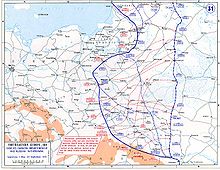
Retreat of Russian troops between May (blue front line) and September 1915 (blue dashed front line)
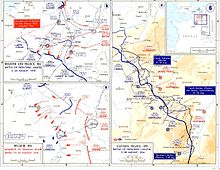
Failure of the French Plan XVII: the border battles on the Western Front from August 3 to 26, 1914.
| German attack planning according to the Schlieffen Plan (left) and its failure (right): Allied troops push into the gap between the German 1st and 2nd Armies on September 8, 1914 | ||

French peasant family on the run, 1914
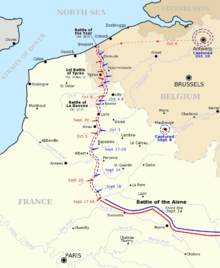
The "race to the sea" was characterized by unsuccessful attempts to embrace the wings of the enemy and roll up his front
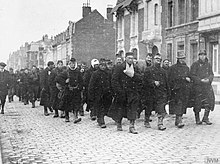
Wounded Belgian soldiers in Calais on November 11, 1914

British and German soldiers fraternize at Christmas 1914 in Ploegsteert, Belgium
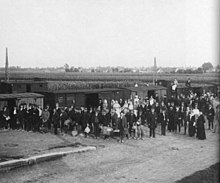
Refugee and evacuation transport from Serbia 1914/15 in Leibnitz
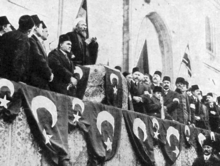
Sheikhülislam Ürgüplü Mustafa Hayri Efendi proclaimed jihad against the "enemies of the Ottoman Empire" on November 14, 1914
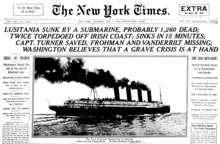
New York Times Extra on the sinking of the RMS Lusitania: "a serious crisis is imminent".
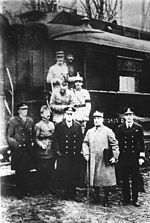
Marshal Foch (second from right) and his delegation in front of the Compiègne carriage after the signing of the armistice
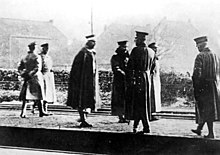
Flight of Wilhelm II (fourth from left) into Dutch exile on November 10, 1918, here on the platform of the Belgian-Dutch border crossing at Eysden

November Revolution: Revolutionary soldiers in front of Brandenburg Gate in Berlin on November 9
._1918._100_x_70_cm._(Slg.Nr._2437).jpg)
Italian propaganda poster (Engl.: They talk about peace and hide the dagger!). Emperor Karl's peace initiatives, which became known in April 1918, are presented as a ruse
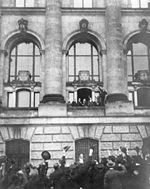
Philipp Scheidemann proclaims the Republic from the West Balcony of the Reichstag on November 9
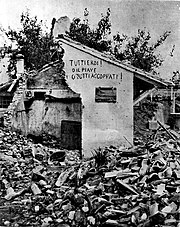
Second Piave battle, house wall with an inscription later famous in Italy (Eng: Everyone is a hero! Either the Piave, or all killed!).
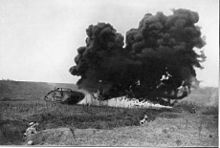
German soldiers increasingly on the defensive in the summer of 1918: attempted defense of a British Mark IV tank attack with a flamethrower
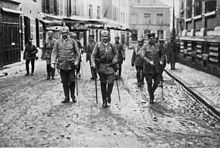
Spring Offensive 1918: Paul von Hindenburg, Wilhelm II and Erich Ludendorff and other members of the OHL on their way to the Great Headquarters in Avesnes-sur-Helpe
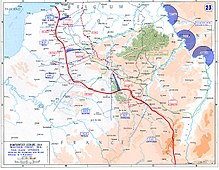
Final Allied offensive, front movement from August 30 (dotted line) to November 11, 1918 (dashed line).
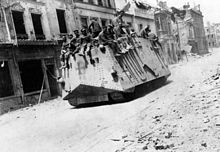
German tank A7V in Roye, about 40 kilometers west of the starting point of the spring offensive
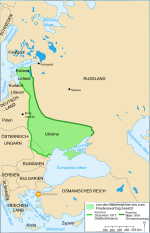
Territorial losses of Soviet Russia until March 1918

November 1917: German soldiers in Jerusalem
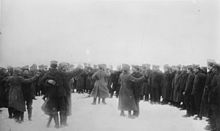
Russian and German soldiers celebrate fraternization during armistice on Eastern Front
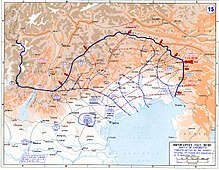
Initial Situation of the 12th Isonzo Battle and Situation Development until November 12, 1917

Eleftherios Venizelos, accompanied by Admiral Pavlos Koundouriotis (left) and General Maurice Sarrail (right), inspects Greek troops
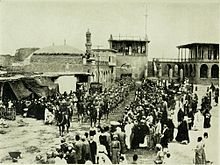
The British Indian Army led by Frederick Stanley Maude marches into Baghdad

Tank attack with air support: The Battle of Cambrai is considered a landmark in the history of warfare

Unsuccessful French assault on a German position almost completely leveled by drum fire
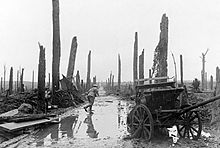
Bombed forest near Ypres

Mass Demonstrations in Petrograd Triggered the February Revolution
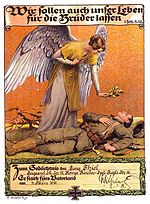
Memorial sheet for the relatives of our fallen heroes
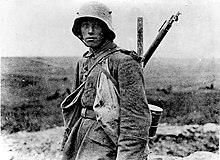
German stormtrooper on the Western Front, late 1916
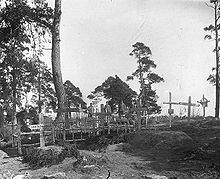
Military cemetery on the Eastern Front, c. 1916
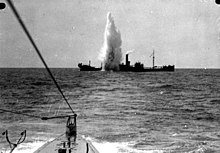
U-boat warfare: Bombardment of a British cargo ship in the Mediterranean by the submarine SM U 35 in the spring of 1917. U 35 sank at least 226 ships, making it probably the "most successful" warship in world history
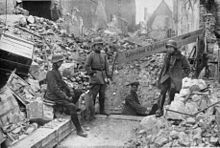
St. Quentin was largely destroyed as part of the Siegfried position, in the picture the entrance to the German commandant's office

Meeting in no man's land
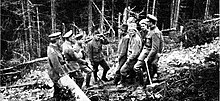
Meeting in front of the Russian wirehouse

Bomb crater around Fort Douaumont end of 1916
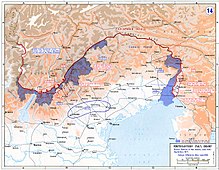
The Italian front 1915 to 1917, Italian conquests in blue

Wilhelm II, Ferdinand I of Bulgaria and Field Marshal von Mackensen in Niš, Serbia (1915)

Bulgarian soldiers around 1916
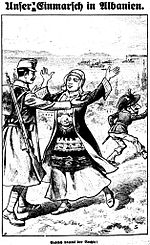
Propaganda cartoon on the occupation of Albania by Austrian troops
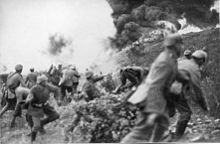
Battle of Verdun, March 14, 1916: attack of German infantrymen on the height Dead Man
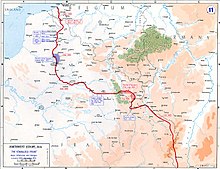
In 1915, the Allies tried to push in the flanks of the great German front arc between Lille and Verdun (upper half of the picture)
.jpg)
Gas attack by the blowing method, infantry on the right side of the picture is ready for the following attack

Champagne: shot forest in the Argonne
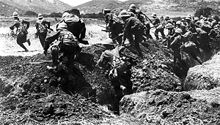
British infantry during an exercise on the Greek island of Limnos for the later attack on Gallipoli
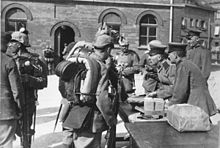
First payment of soldiers after mobilization, Berlin, 1914
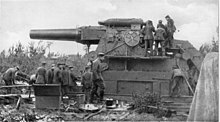
A rail-mounted 42-cm Krupp bed gun ("Dicke Bertha") is made ready for firing near Liège on August 7, 1914
Individual aspects
War enthusiasm and anti-war demonstrations
→ Main article: August experience and ideas of 1914
At the beginning of the war, people showed a broad spectrum of very different reactions, ranging from protest and refusal to perplexity and shock to patriotic exuberance and hysteria. There was no general enthusiasm for the war, nor were the proletarian and peasant classes united in their consistent opposition to it. Above all, large sections of the bourgeois-academic strata welcomed the coming war event. The conservative middle classes reacted to the ultimatum and Austria-Hungary's declaration of war on Serbia with patriotic processions, for example in Berlin-Mitte on July 25, 1914, with about 30,000 participants. In smaller towns and especially in rural regions, on the other hand, the mood was decidedly downcast, pensive and pessimistic. Similarly subdued and depressed reactions to the coming war were to be found among the working classes in the industrial centers. In none of the countries affected by the outbreak of war was there a "frenetic" enthusiasm for war that gripped all strata of the population.
On the other hand, similar to Britain and France, anti-war demonstrations took place in Germany at the end of July, including 288 rallies and marches in some 160 cities in Germany alone (according to the SPD), for example in Berlin-Mitte on July 28, 1914, with more than 100,000 people, and this despite a ban by the magistrate. The turning point toward the Burgfrieden was the news of the Russian partial mobilization on July 28, 1914. Similar to the labor movement in other countries, the Social Democrats joined the political united front, although they had opposed their own government's "warmongering" only a few days earlier. On August 1, 1914, between 40,000 and 50,000 people gathered in front of the Berlin City Palace for the second balcony speech of Wilhelm II, who announced that he "no longer knew any parties or denominations." Reich Chancellor Bethmann Hollweg also cleverly managed to portray Russia as the supposed aggressor. SPD party executive Hugo Haase, who had organized numerous anti-war rallies and was still fighting within the party against the acceptance of the war credits until August 3, 1914, declared on behalf of the SPD the following day: "We will not abandon our own fatherland in the hour of danger." In all countries involved in the war, there was broad political solidarity at the beginning of the war, a concerned, serious and determined acceptance of the war.
War Targeting Policy
→ Main article: War aims in the First World War
Germany's military war objective, which was initially in the foreground and contributed significantly to the outbreak of war, was - in accordance with the War Council of December 8, 1912 - to wage the war against the Entente, which was considered inevitable, at a time that was still favorable, whereby the middle of 1914 had already been considered favorable in the War Council of 1912. In the view of the German military leadership, the European balance of power was developing increasingly unfavorably for Germany. Triggered by the army's rapid successes in the Western campaign, annexations in the east and west to secure a hegemonic position for the German Reich on the European mainland were added as political goals, which were reflected, among other things, in the "September Program" of 1914. The annexation demands, which became increasingly difficult to reconcile with the overall military situation in the course of the war, were a major obstacle to peace negotiations.
Austria-Hungary claimed to be fighting for its interests in the Balkans and for its very existence. Contrary to the nationalist tendencies of the time, Austria-Hungary adhered to the universal idea of the imperial state and thus to the multiethnic state. The official war aim of the Austro-Hungarian Monarchy was thus to maintain its existence and strengthen its position as a great power. At the same time, Austria-Hungary sought the incorporation of Serbia, Montenegro and Romania or, instead of the latter, Russian Poland.
France's primary wartime objective was the recovery of Alsace-Lorraine. In the fall of 1915, other French war aims began to emerge: Pushing Germany back to the Rhine by annexing or neutralizing the Rhineland to the point of dissolving imperial unity or at least weakening it in a federal sense, and an economic and military annexation of Belgium and Luxembourg to France. According to the war aims program of the Briand government of November 1916, France was to receive at least the border of 1790 and thus Alsace-Lorraine with the Saarland. The establishment of two neutral, independent buffer states under French protection was preferred to a permanent occupation of the Rhineland. Contrary to the ideas of the general staff, Belgium was to be left in independence.
Russia saw itself as a natural protective power of pan-Slavist aspirations in the Balkans. After the Ottoman entry into the war, the Russian side hoped to gain Constantinople and the straits between the Aegean and the Black Sea (→ Agreement on Constantinople and the Straits). In addition to the old goal of the straits, however, Russian war aims also included Galicia and East Prussia, which extended into Russian territory. In his 13-point program of September 14, 1914, Russian Foreign Minister Sasonov envisaged primarily territorial cessions of Germany, ostensibly on the basis of the principle of nationality. Russia would annex the lower reaches of the Njemen (Memelland) and the eastern part of Galicia, and annex the eastern part of the province of Posen, (Upper) Silesia and western Galicia to Russian Poland.
At the beginning of the war, Great Britain demanded the restoration of the respective independence of the smaller European nations that had been destroyed by the Central Powers' attack, especially that of Belgium, whose invasion was the official reason for entering the war. To the goal of liberating Belgium was added the formula of crushing Prussian militarism. On March 20, 1917, Lloyd George described the elimination of reactionary military governments and the establishment of democratically legitimized governments as war aims that would contribute to the creation of international peace. Increasingly, his own expansionist desires also emerged in the form of demands for self-determination for the German colonies and the already occupied Arab parts of Turkey under British rule. Russia's withdrawal from the wartime coalition and, to a lesser extent, France's desire for annexation jeopardized the British concept of the balance of power, even in the event of an Allied victory. In the East, a cordon sanitaire of states dependent on France and Great Britain was now to be created in order to create a new counterweight to Germany. At the inter-Allied economic conference in Paris from June 14 to 17, 1917, negotiations were held, not least on British initiative, on a post-war economic order that would permanently hold down Germany's position in world trade. Britain was also particularly interested in the breakup of the Ottoman Empire and the division of Arab territories. The Sykes-Picot Agreement of May 16, 1916, settled the zones of interest of Britain and France in the Middle East. Britain received southern Mesopotamia, while Palestine was to be internationalized. Britain insisted on the surrender of the bulk of the German fleet.
Italy's war aims lay primarily in the annexation of Italian-populated territories under Austro-Hungarian rule (→ irredentism). After the Russian Empire agreed to Italy's desire to annex Slavic-populated territories and thus establish the Adriatic as mare nostro ("our sea"), the Secret Treaty of London came into being on April 26, 1915.
The American war aims were formulated in the 14-point program of January 8, 1918. It contained the complete restoration of Belgian independence, further the return of Alsace-Lorraine, the fixing of Italian borders along nationality lines, and the continued existence of Austria-Hungary, whose nations were to be allowed free development. Turkey was granted independence, but without the inclusion of other nationalities, and the straits were to be kept open by international guarantees. The establishment of an independent Polish state was demanded. In October 1918, the Americans supplemented and expanded Wilson's 14 points: Italy was granted South Tyrol for strategic reasons, as well as a protectorate over Albania; the liberation of all Slavic peoples under German and Austro-Hungarian rule was demanded; and the division of the Middle East between Britain and France was recognized.
War Economy
The central problems of the war economy were regulating the relationship between the state and the economy, maintaining industrial peace, restructuring for armaments production, securing consumption and financing the war. The economic potentials of the Central Powers and the Entente were already unequal at the beginning of the war; the former had only 46 percent of the population and 61 percent of the Entente's social product.
At the start of the war, those provisions intended for military mobilization and a short war came into force; for example, exports of war-essential products were prohibited, food imports were facilitated, and maximum prices were set for some goods. The gold standard, the basis of most prewar currencies, was suspended in the belligerent countries. These measures were often insufficient. For example, the munitions crisis of 1914/15 initiated the transition to a wartime economy. The origins of the "total war" propagated by Ludendorff in 1935 and later by the National Socialists can be found in the war economy of the First World War.
War-related restrictions stood in the way of the transition: France had lost a large part of its industrial potential due to the German occupation in the north, Russia was industrially underdeveloped and largely cut off from Allied supplies by the naval blockade of the Dardanelles and the Baltic Sea, and German foreign trade, for its part, was severely restricted by the British naval blockade. Great Britain's foreign trade was seriously threatened by submarine warfare only in the first half of 1917. The U.S., on the other hand, did not have to mobilize its economy to the same extent as the belligerent states in Europe. The state gained considerable influence over the economies from 1916/17 onward, and government spending ratios increased substantially, from 17 to 70 percent in Germany, from 13 to 48 percent in Great Britain, and from 1.4 to 22 percent in the United States.
Apart from the armaments sector, industrial production fell in many belligerent states. In the German Reich, for example, industrial production as a whole fell by almost half. The decline was weaker in Great Britain, while there were hardly any restrictions in the USA. Agricultural yields also fell in most belligerent states, again with the exception of Great Britain and the USA. One bottleneck in the transition to a wartime economy was the supply of raw materials, due on the one hand to naval blockades (affecting the Central Powers and Russia) and in France to the separation of the northern departments. Another bottleneck, especially in the Central Powers and in France, resulted from the fierce competition between the army, which needed more and more soldiers, and industry, which needed qualified personnel.
Cooperation and discipline were used in varying proportions to maintain industrial peace: In Austria-Hungary, workers in armaments factories were tied to their jobs and subject to military control and jurisdiction. In Germany, there was no militarization of labor relations; however, the Auxiliary Service Act of December 5, 1916, introduced compulsory service, while corporatist arrangements ensured union approval. In France, the Loi Dalbiez (named for politician Victor Dalbiez) of August 15, 1915, kept deferred workers under military supervision. In Britain, the Treasury Agreement with the unions and the Munitions of War Act 1915 restricted the right to strike and the free movement of armament workers. In the U.S., there were no comparable restrictions, but the Selective Service Act of May 18, 1917 (to build up the army) could be used to direct labor into the armaments industry.
Despite the enlistments, the number of employees in the war economy hardly decreased or increased; through the spread of mass and assembly line production, it was able to greatly expand its production. In Germany, the number of employees in the armaments industry rose by 44 percent, while that in civilian production fell by 40 percent. Prisoners of war, conscripts and foreign workers (mainly from the colonies) were used to varying degrees. At the same time, women and young people joined the workforce; in Great Britain, for example, the number of working women increased by 23 percent, in Germany by 17 percent.
Private consumption - important for morale on the home front - was subordinated to the war economy in all countries, but they succeeded to varying degrees in distributing the available goods fairly, or at least in giving the impression that they were doing so. The U.S. hardly had to accept any restrictions; in Great Britain, supplies were managed comparatively well. But even there, spending on private consumption fell by about 20 percent between 1913 and 1918. In France, food supplies were relatively well maintained in cooperation with the Allies. In the case of the Central Powers, on the other hand, considerable problems arose - not only because of the naval blockade - which resulted, among other things, from the compulsory state economy that had already begun in 1914. The supply problems and, above all, the injustice in the distribution of food undermined the authority of the state and led to unrest. The situation was similar in Russia. Supply policies in favor of urban consumers and industrial workers fizzled out because of their inconsistency and lack of coercive means. The tsardom disintegrated into supply regions - excluding the cities - as peasants marketed less and less.
Public spending to finance the war increased dramatically. In Great Britain, the last war budget was 562 percent higher than the first, in Germany it was 505 percent, in France 448 percent, and in Russia (by 1916) 315 percent. The war cost about $209 billion (adjusted for inflation in 1913 prices: $82 billion). In terms of the amount of money spent, it was "cheaper" to lose the war than to win it: The Allies spent $147 billion on the war effort, the Central Powers $62 billion.
In all countries, the war was financed by taxes, bonds or money creation. The public sector obtained money for government spending from central banks in exchange for short-term debt instruments. After the money had flowed to the economy and households, it was partially siphoned off again through taxes or bonds. Since tax increases were only used to a limited extent to finance wars for various reasons (truce, less efficient tax systems) (France 15 percent, Germany 17 percent, Great Britain 26 percent), all warring states relied primarily on loans (war bonds), which the enemy was expected to pay in the form of reparations after the war. Further, the Allies in particular borrowed heavily abroad, primarily from the United States. In total, inter-Allied debts amounted to $16.4 billion.
After the war, Germany faced a debt mountain of 156 billion marks (1914: 5.4 billion), Great Britain 5.8 billion pounds (1914: 0.6 billion). The French national debt increased by 130 billion francs and the American by 24 billion dollars. The money supply had grown by 111 percent in Great Britain and by 285 percent in Germany, laying the foundation for German inflation by 1923.
See also: German economic history in the First World War
Trench warfare
→ Main article: Trench warfare in the First World War
Positional warfare and trench warfare are virtually considered "emblematic" and defining forms of World War I: warfare along permanent, fortified front lines, "millions of soldiers entangled for years in the mud in a senseless struggle only to achieve tiny gains in terrain at tremendous loss, a bloodletting for years for the population and resources of the warring nations." This trench warfare characterized primarily the situation on the roughly 700-kilometer-long Western Front between November 1914 and March 1918, but at times it also characterized the situation on the Eastern Front and the Italian Front. Until 1914, all the great powers had envisaged a war of movement in their war plans. After the failure of the Schlieffen Plan and the mutual outflanking in the race to the sea, the armies dug in. The reasons for the solidification of the fronts were the level of military technological development, which favored the defender, as well as the initial loss of control in the operational command of mass armies and the relative balance of forces.
In January 1915, the German Supreme Army Command ordered that front-line positions on the Western Front be developed so that they could be held against numerically superior forces. Combat experience initially led to the shifting of the line - as far as possible - to a rear-hanging position and the introduction of a second line; from about the end of 1916, the warring parties had introduced three trench lines in many areas, and the simple trench line increasingly developed into a deeply staggered system of positions and an elastic zone defense. Successful attacks required local superiority and careful preparation. At first, attempts were made to destroy the enemy's positional system with artillery preparation lasting several days, but treacherous; attacks increasingly became material battles with previously unheard-of ammunition consumption. Further attempts to soften the ossified fronts were the use of poison gas (gas warfare), blasting of mines (mine warfare), the introduction of tanks, grenade launchers and submachine guns ("trench sweepers"). The hand grenade experienced a renaissance, while the bayonet almost lost its importance as a conventional close combat weapon: in the narrow trenches, (sometimes sharpened) field spades were used rather than blank weapons. The German army reacted with tactical changes, especially in the spring offensive of 1918; shock troops pushed through the lines without regard for remaining resistance and sought to destroy the rear infrastructure with these "infiltration tactics." On the other hand, it was precisely in this war of position that there was the so-called "live and let live," a non-agreed-upon occurrence of non-aggressive behavior between opposing units, which was maintained in some front areas over a longer period of time.
The everyday life of soldiers in the trenches was characterized by alternating phases of long inactivity and sharpened struggle for survival. The results were, on the one hand, art forms such as "trench art" ("trench work"), on the other hand, severe war neuroses (for example, in the case of those buried under rubble) and war traumas (such as "war tremors") or even previously hardly known fear reactions such as the so-called "fear sleep" (sudden falling asleep in the trenches, especially before attacks).
Gas war
→ Main article: Gas warfare during the First World War
On April 22, 1915, up to 5,000 people fell victim to a German use of chlorine gas at Ypernbogen (today's estimates: 1,200 dead and 3,000 wounded). This date is now regarded as the birth of modern weapons of mass destruction and the actual beginning of the gas war, which changed and challenged the image of the soldier and the notion of war as "chivalrous combat" much more radically than the new introduction of other means of combat. The military leadership was completely surprised by the resounding success of the first use of the blowing method developed by Fritz Haber and was unable to exploit it due to a lack of reserves; moreover, the attackers were also affected by the gas. The Allies regarded the massive use of lethal gases as a clear violation of the Hague Regulations on Land Warfare and as further proof of "barbaric" German warfare. Although the use of chemical weapons was no longer a novelty, only irritants had previously been used in this war, and they were not very effective. The failure of offensive warfare, the grueling trench warfare and the munitions crisis due to a lack of saltpeter, as well as the superior but underutilized German chemical industry led to the decision in favor of this means of combat. Although the German officer corps had misgivings, they ultimately accepted its use as a supposedly necessary evil. On May 31, 1915, phosgene ("green cross") was added for the first time during a German attack on the eastern front near Bolimów. Most of the deaths by gas in the First World War can be traced back to the effect and, above all, the late effects of this warfare agent, which was used in ever greater concentrations. On September 25, 1915, the British opened the first large-scale gas attack at the beginning of the Battle of Loos, which also made it possible to break into German positions.
In the fall of 1915, the first gas masks were introduced. Increasingly, the warring parties fired the gas with grenades in order to be less dependent on the wind direction. On July 10, 1917, the first use of "mask breakers" ("blue cross"), which penetrated the filters of the gas masks, occurred at Nieuwpoort. At the same time or shortly thereafter, they usually fired a lung-damaging, usually lethal warfare agent (for example, "green cross"), since the irritation of coughing often caused the soldiers to remove their masks ("buntschießen"). Two days after the first use of "Blaukreuz," again at Ypres, an entirely new combat agent followed, the contact poison mustard gas ("Gelbkreuz"), also called "hun stuff" by the British. Mustard gas causes severe injuries (similar to chemical burns) to the skin, eyes and bronchial tubes and, in the case of high exposure, death. When mustard gas was used, it was taken into account that severely injured people who required a lot of care were more of a burden on the other side than dead people.
A total of about 112,000 tons of poison gas were used in the First World War, 52,000 tons of which were used by Germany. The exact number of those poisoned and killed by combat gas in the First World War is difficult to determine, especially since a large proportion of the soldiers did not die of the late effects until after the war: estimates for the Western Front are around 500,000 injured and 20,000 dead, although the number of dead must probably be put even higher. No reliable figures are available for the Eastern Front.
See also: List of chemical warfare agents
Air war
The less robust aircraft at the beginning of the war were mainly used for aerial reconnaissance. They thus fulfilled an important task that was initially underestimated by many generals.
When the British arrived in France, they brought with them only 48 reconnaissance planes. They observed the front and reported enemy movements to the high command. It was largely thanks to them that General Joffre launched the offensive on the Marne. In its advance, the German army had intended to bypass Paris to the west. When it unexpectedly veered southeast, leaving a large gap between armies, it was first noticed by Royal Flying Corps (RFC) aviators. They passed the observation on to the French chain of command, which was then able to launch the counterattack on the Marne.
Aerial reconnaissance and aerial photography gained importance, which is why the first methods to fight them were developed. When the war of position began, aviators were used for artillery coordination. The introduction of telegraphic fire extinguishing radio transmitters since 1915 was synonymous with the actual beginning of aeronautical radio.
French aviation pioneer Roland Garros was the first to develop a true fighter aircraft. He mounted a machine gun on the tip of his aircraft in 1915. To protect the propeller blades from damage, he reinforced them with steel plates. In the spring of 1915, he used his new weapon to hunt German planes, most of them still unarmed, over Flanders for 18 days until he was shot down on one of his missions.
A little later, Dutchman Anton Herman Gerard Fokker installed a breaker gear in his Fokker E.III. The synchronization caused the MG to cease firing whenever it would have hit the propeller. The first successful pilots of these machines were Max Immelmann and Oswald Boelcke, who established the reputation of the Fokker Scourge. Until early 1916, the Germans dominated the skies over the Western Front.
Attacks by bombing increased during the course of the war. The first bombs were dropped by German zeppelins over Liège on August 6, and others over Antwerp on August 24, 1914.
In December 1914, German airships also attacked the British Isles for the first time. Until 1917, heavy attacks on London were flown, after which some industries had to shut down operations. After that, the airships, which offered too large an attack surface and were too immobile, were increasingly replaced by large aircraft. By 1918, German bombs dropped from zeppelins had killed 1400 British civilians and wounded nearly 5000. The Royal Flying Corps, in turn, concentrated its attacks on the industry of western Germany and the Zeppelin factories on Lake Constance. The First World War was the first war in which bombers were used. These were particularly large and stable biplanes that could drop aerial bombs, some weighing more than half a ton.
In the course of the militarization of aviation, armaments were deployed over the seas. Seaplanes that had previously been used only for reconnaissance and naval aircraft that landed on the water were armed and used against ports, coastal fortifications and military units by air and sea. World War I was also the first war in which early aircraft carriers were used. The U.S. and British converted several of their warships for this purpose. These early models were only suitable for use by seaplanes, which took off from the deck, landed near the aircraft carrier, and were then transported back on board by crane. The accelerated development of aircraft carriers against the backdrop of World War I was to prove decisive during the fighting in the Pacific during World War II.
From 1916, the Germans lost their air superiority again. The Allies had reorganized and were flying very successful attacks with some robust aircraft (for example, Nieuport 11). The Germans responded. Oswald Boelcke trained some of the best aviators and imparted his combat knowledge to them, which he wrote down in the Dicta Boelcke. The German fighter squadrons (Jasta for short), especially the Jasta 11, inflicted heavy losses on the Allies. After Boelcke's death, Jasta 11 was led by Manfred von Richthofen in early 1917. He and his pilots provided the bloody April in which the Allies lost 443 airmen. Richthofen himself shot down 20 planes during this period, while his brother Lothar brought the total to 15 kills. Another pilot, Kurt Wolff, achieved 22 aerial victories in this April.
When the U.S. arrived in 1918, the tide turned. The Americans were inexperienced, but their numerical superiority in aircraft could not compensate for the Germans. Beginning in the summer of 1918, the imperial pilots had to try their luck with dive-bombers, otherwise they stood no chance against the Allied squadrons. As a result, the Allies had several squadrons flying on top of each other, which continued to harass the Germans.
On April 21, 1918, Manfred von Richthofen was shot down by an Australian machine gunner while being pursued by Arthur Roy Brown. He was the most successful fighter pilot of World War I, with 80 confirmed aerial victories. The loss of their idol and increasing supply difficulties took their toll on the German fighter squadrons. The air forces could contribute little to the outcome of the war. The war was decided on the ground.
Numerous fallen German airmen, including Richthofen, were buried in Berlin's Invalidenfriedhof.
See also: section "First World War" in the article "Air war".
Naval warfare
→ Main article: Naval warfare in the First World War
Before 1914, the war at sea was considered to play a major, if not decisive, role. In fact, the Battle of the Skagerrak was the "greatest naval battle in world history," but it was not the decisive battle that everyone expected. The share of the naval war in the outcome of the First World War as a whole was thus not decisive and was more significant in its indirect effect.
In all theaters of war, there was a clear superiority of one side: Great Britain over Germany in the North Sea, Germany over Russia in the Baltic Sea (de facto), France and Italy over Austria-Hungary in the Mediterranean (except the Adriatic), and Russia (since late 1915) over Turkey in the Black Sea, although Turkey nevertheless managed a continued blockade of the Black Sea straits. The seas were predominantly a movement area for the Entente's fleets, merchant ships and troop transports, but not for those of the Central Powers.
The blockade of the North Sea by the Royal Navy in the form of the Northern Patrol around Scotland and the Dover Patrol in the English Channel contributed significantly, according to Anglo-American naval historians decisively to the exhaustion of the Central Powers, the blockades of the Baltic Sea and the Dardanelles played a significant role in the defeat of the Russian Army. Actions of the German Mediterranean Division were the cause of the Ottoman Empire's entry into the war on the side of the Central Powers. Cruiser warfare - the means per se of numerically inferior naval forces - played only an insignificant part in the war due to the lack of preparation on the part of the German Admiralty and the lack of bases. Unexpectedly, submarine warfare emerged as the most significant part of the naval war. Because the U-boat was underestimated as a weapon by all sides, naval forces were generally ill-prepared for submarine warfare. German submarines nevertheless caused serious trouble for the Entente, especially in the first half of 1917. The U-boat war indirectly led to the entry of the United States into the war and ultimately to the defeat of the Central Powers.
The order for the decisive battle at sea was not given until the Supreme Army Command had given the war away, and led to the Kiel sailors' uprising, which in turn triggered the November Revolution.
Propaganda
→ Main article: Propaganda in the First World War
Propaganda essentially promoted motivation for military service and support for participation in the war among one's own population or hoped-for allies, using xenophobic prejudices and patriotic symbols. For the first time in history, the belligerent states established their own authorities for this purpose.
In the German Reich, the Central Office for Foreign Service was set up for propaganda purposes on October 5, 1914, followed by the Military Office of the Foreign Office (MAA) on July 1, 1916, and finally the Bild- und Filmamt (BUFA) on January 30, 1917. In Austria-Hungary, the k.u.k. Kriegspressequartier (KPQ), which had already been set up on July 28, 1914, was responsible. Kriegspressequartier (KPQ) was responsible. On the Allied side, the Maison de la Presse was founded in France in February 1916, the War Propaganda Bureau existed for the same purpose in Great Britain, and the Committee on Public Information in the USA.
In the German-speaking part of Austria-Hungary, propaganda showed, among other things, war-glorifying drawings in poster size with the illustrated statement "Every kick a Britt, every thrust a Franzos, every shot a Russ" and "Serbia must die" find. The "Lord Kitchener Wants You" motif was copied many times during the war.
Prominent British scholars, following reports of the fire at the University Library of Louvain in late August 1914, declared that the German army had deliberately set the fire. Prominent German scholars responded with counter-statements, including the Manifesto of the 93 and the Declaration of the University Teachers of the German Empire, which sought to justify the World War as a cultural struggle and defensive war, which in turn prompted a British response to the German professors. The "Hun Speech," with which Wilhelm II had urged German troops sent to China in 1900 to suppress the Boxer Rebellion to engage in a ruthless campaign of revenge, subsequently earned the Germans the appellation "huns" in Anglo-American countries. Other propaganda campaigns included the alleged crucifixion of nuns at church gates in Belgium and the alleged cutting off of children's hands by German troops in Belgium, reflected in the Bryce Report, among others.
Well studied is the attitude of the British press: It had adopted an increasingly positive attitude toward Germany in the last two years before the war. Among other things, the newspapers expressed the opinion that German naval armament, while troublesome, posed no real danger to the Royal Navy. During the July crisis, the Russian czar was initially held primarily responsible for the escalation. This changed with the German ultimatum to Russia and especially with the invasion of Belgium and Luxembourg. As the war continued, Germany was not only discredited as an adversary and branded as the bearer of sole war guilt, but was stylized as the enemy of all mankind. Only at the beginning of the war was a distinction made between the government and the population. This exaggerated atrocity propaganda was one reason why no peace of understanding or negotiation was achieved, and it made reconciliation more difficult on all sides after the war. The National Socialists were later able to cover up their crimes more easily with reference to this propaganda (Völkischer Beobachter of September 4, 1939: "Atrocity reports as of old").
The atrocity propaganda of the Central Powers was less pronounced, if only because hardly any German territory was occupied and thus comparatively few German civilians were exposed to direct effects of the war. Primarily, the Russian side (army and population) were vilified. The use of colored colonial troops on European battlefields by the Allies was alternately denounced as a cultural breach or as immoral. The propaganda departments of the Central Powers tended to disparage and ridicule the enemy and to emphasize their own strength. To this end, numerous pictures were published and distributed as postcards showing fallen Allied soldiers and corresponding mass graves.
In Germany after the war, enemy - namely British - propaganda was judged to be much more effective than Germany's own; not a few attributed Germany's defeat in the war to enemy propaganda. Wilhelm II, in his Dutch exile, wrote of the British publisher Northcliffe, whose newspapers were at the forefront of anti-German propaganda: "If we had had a Northcliffe, we could have won the war." Erich Ludendorff also expressed his appreciation after the fact. Adolf Hitler, in Mein Kampf, spoke extensively about war propaganda and summed it up momentously: "I, too, have learned immeasurably from this enemy war propaganda."
Weaponry development
The First World War revolutionized weapons technology in numerous aspects. In infantry equipment, World War I brought the final breakthrough to camouflage clothing and the steel helmet. The infantry's rifles were roughly equal; only the British Lee-Enfield was superior to those of the other belligerents due to its rapid firing sequence and caused high German casualties, especially in Flanders. The trench warfare brought about a renaissance of the hand grenade; only the Central Powers had sufficient quantities at the beginning of the war; the British had phased them out in 1870. The machine gun evolved from heavily transportable models (e.g., the German MG 08 weighing 30 to 40 kg) to lighter models (e.g., the later proverbial MG 08/15 weighing 14 kg). Significantly, the first "real" MP 18 submachine gun was also called the "trench sweeper" and was used primarily to support new infantry tactics (assault troops).
Machine guns and later tanks made the traditional use of cavalry an anachronism; the era of the old-fashioned "battle cavalry" had already inevitably come to its end in 1914; cavalry lost its status as the main armament in World War I and was used primarily for armed reconnaissance and terrain protection. In the vast spaces of the Eastern Front, both sides still made extensive use of their cavalry forces, especially in the war of movement in 1914/15, the British in Palestine toward the end of the war. In the later years of the war, all belligerent powers greatly reduced their cavalry forces.
From the first moderately successful Mark I tank, the Allies developed the effective Mark IV assault weapon and the "ancestor" of today's tank types, the Renault FT. Until the end of the war, Germany developed only inadequate defenses such as the so-called M1918 tank rifle. The only mass-produced German tank, the A7V, could not be produced in sufficient numbers: only 20 A7Vs faced 1220 Mark IVs and 2700 Renault FTs, as well as about 2,000 other Allied armored vehicles, exemplifying the Allies' material superiority in the last year of the war.
In the course of World War I, the limitations of artillery led to a rise in the importance of bombers. For example, the "Dicke Bertha," which was sometimes effective against fixed targets at the beginning of the war, showed system-related weaknesses (immobility, high firing wear, moderate accuracy). The technically sophisticated Paris gun had no military value due to its very low accuracy and is considered a pure "terror weapon" against civilian targets. The light and mobile French "Canon 75" revolutionized artillery even before the war and showed its efficiency against German attack, especially in the early stages of the war, but proved too small-caliber for the requirements of positional and trench warfare. The ratio of light to heavy batteries shifted from 11:2 at the beginning of the war to 9:7 at the end of the war for the warring parties in the context of the war of position.
Provisional aircraft gave rise to the first mass-produced fighters (e.g., Fokker E.I), which targeted the enemy with rigidly mounted machine guns and the entire aircraft. Also developing from provisionals were early long-range bombers such as the German Groß- und Riesenflugzeuge or the British Handley Page Type O, which increasingly replaced wartime zeppelins. World War I can also be equated with the actual beginning of aeronautical radio, which raised the possibilities of aerial reconnaissance to a completely new level.
The submarine - before the war considered at best an auxiliary weapon - became the central offensive weapon in the naval war. The superior radio reconnaissance ("Room 40") of the British hampered the deployment of the High Seas Fleet until relevant operations in the North Sea came to a complete standstill. The British hardly used their superior Grand Fleet offensively, mainly due to the threat of submarines, so that the decline in importance of capital ships began with the First World War.
Apart from the mobilization of all reserves within the framework of the war economy, the industrialized war was demonstrated by the fact that it was predominantly ranged weapons that determined the events of the war: artillery caused about 75 percent of all injuries in the war, infantry weapons about 16, hand grenades 1 to 2 and poison gas just under 1.7 percent. Traditional "blank" weapons (saber, dagger, sidearm) inflicted only 0.1 percent of wounds in the entire war. However, it fits less into the picture of the industrialized and thus "modern" war that just under one tenth of the German, one sixth of the Austro-Hungarian and one fifth of the French dead fell victim to disease.
See also: Military equipment in the First World War
Judgment of the military
The World War disaster of warfare, as unexpected as it was all-around, had its essential cause in the uneven development of technology and military tactics. In the last 30 years before the war, new inventions in weapons technology accumulated: low-smoke powder, small-caliber multi-loading rifles, rapid-fire guns, machine guns, aircraft and much more condensed into a "critical mass" whose behavior and consequences could not be easily assessed without the "great experiment" that broke loose in the summer of 1914.
Both the German and French army leaderships tried to ignore and devalue the ever-increasing emphasis on technology in their profession and, in contrast, to place the will and the idea of attack in the foreground. The emphasis on combat morale ("offensive à outrance") lent itself to relativizing the problems caused by the mechanization of armaments. Accordingly, only one-sided lessons were drawn from the siege of Port Arthur (1904/05), although the new military-technical situation of industrialized war was already clearly apparent here.
What was special about the military doctrines in France and Germany was not their focus on the offensive, but their unique exaggeration - tactical reason was practically lost. Last but not least, the ideological imprint of Social Darwinism played a role. Social Darwinism offered the craft of warfare a new, quasi-scientific legitimation: modernization consciousness combined with an emphasis on the vital element of warfare, thus leading to a path that, in the face of an unprecedented development of weapons technology, led to immense bloodbaths. Nowhere were military leaders willing to acknowledge that the uneven level of development of firepower and movement made offensive warfare of movement impossible. Victory could only be won with sacrifices that were disproportionate to the gains, even by the standards of the time.
Frontline Experiences
The First World War with its material battles brought about a change in the self-perception and external perception of soldiers. Before the First World War, the general idea of war was still characterized by open field battles in which the soldier was supposed to stand up to the enemy in a daring, chivalrous and heroic manner. Almost all Germans were stuck in their conception of war at the level of 1871 and earlier. Accordingly, war was conceived as an "open, honest fight with chivalrous weapons" that would bring adventure, romance, and personal heroism to the participants. Thus, commercial prostitution was widespread both at the front and at the stage. It took place in brothels separate for soldiers and officers, controlled by military doctors and sometimes even operated by the military itself. But the glorified view of war could not withstand the realities of the war of position. The experience at the front destroyed such notions: "Courage, bravery and skill - all superfluous..." The war did not bring soldiers the hoped-for adventure and heroism, but rather the disturbing experience of a complete degradation of the individual to a defenseless object of the war machine, creating the image of a depersonalized and industrialized war.
This impression was decisively shaped by the almost incessant fire of artillery, which claimed more than half of the war's victims. The soldiers' only reaction to this weapon was to wait helplessly for the impact, for the onset of a force they could not influence: "The machinery of war seemed to become omnipotent, imposing its decisions on those who participated in its opaque movements." Accordingly, the iconography of a new type of soldier emerged; the "emotional, spontaneous, and loyal youth" of the Langemarck myth gave way to the Verdun fighter, in the ideal image a "trained, cold, aggressive, isolated, and technically equipped leader figure." The steel helmet thereby became the symbol of the soldier, representing the modern, technical and functional appearance of war.
Paradoxically, the static order of trench warfare also inherited a tendency to limit violence as long as soldiers on both sides were engaged in securing the status quo, which was the case in large areas of the front outside of major offensives. To break up this situation, the army commands employed specialists in the use of force, mainly snipers on the British side and shock troopers with high individual combat motivation on the German and Austrian sides, who were extremely unpopular with the normal troops because of the escalation of violence they pursued. These special units perceived themselves as perpetrators in an emphatic sense. "Accordingly, it is also no coincidence that here, in addition to the German shock troops, a direct line of continuity with the fascist aestheticization of violence in the interwar period can also be drawn in the case of the Italian elite units, the 'Arditi'" and was also justified from the perspective of depth psychology and cultural studies.
| 1914: Rider of the German Schutztruppe in German Southwest Africa | 1918: The Renault FT became formative for later tank types up to the present day |
| Photo of a mass grave near Vimy (or possibly near Fromelles), as first published as a postcard in 1916 | Presumably because of the officers' too casual attitude in the face of the fallen, the picture was retouched so that no officers were visible anymore |
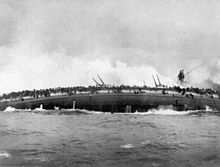
Sinking of the German large cruiser SMS Blücher in the battle on the Dogger Bank, the crew tries to save themselves over the ship's walls (famous war photograph)
._Destroy_this_mad_brute_(Vernichte_dieses_verrückte_Vieh)._1917._82_x_59_cm._(Slg.Nr._3262).jpg)
US propaganda poster: "Destroy This Mad Brute - Enlist". The woman was supposed to represent neutral Belgium occupied by the Germans
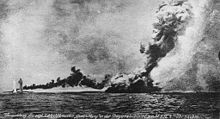
Skagerrak battle, "greatest naval battle in world history", in the picture the Queen Mary explodes
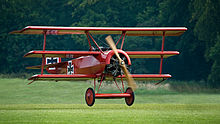
A replica of the Fokker Dr.1 triplane as flown by Manfred von Richthofen.
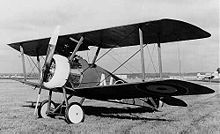
Sopwith Camel

Play media file Silent film about US pilots
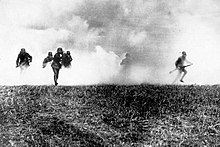
German infantry during a gas attack near Armentières, spring 1918

Air combat (oil painting by Michael Zeno Diemer from 1918): German Albatros C.III fighter two-seater comes to the aid of a comrade (bottom right) who is being harassed by British aircraft (possibly Martinsyde G.102) after a British plane has been shot down.

Canadian soldier with moderate mustard gas burns
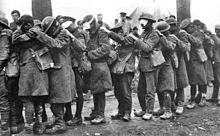
British soldiers blinded by poison gas await treatment
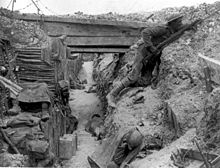
Originally German trench, occupied by British during the Battle of the Somme.

Aerial view of the trench system at Warneton (West Flanders) on September 3, 1917.
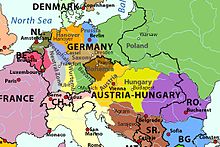
French Extremists' Ideas of a Postwar Order in Europe (1915)
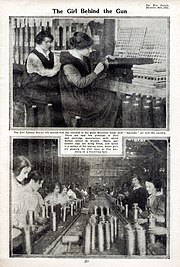
Women working in an English armaments factory (1915)

Women at the National Shell Filling Factory, Chilwell.

German war aims in the West

Reservists on trucks, Berlin, 1914
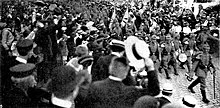
Departure of the Lübeck Regiment on 31 July 1914
_-_Gassed_-_Google_Art_Project.jpg)
Victims of a gas attack according to the account of John Singer Sargent
Consequences of War
The consequences of the war are not limited to the facts described in more detail below. The First World War is considered by some authors to be the "threshold of an epoch. It reordered international relations. It destroyed existing concepts of social order and, in most of the defeated states, the national political systems. The war took the entire society of a state, it left no sphere of life untouched and thus seriously changed the living conditions of the people. "War [...] acted as a kind of 'space of change' within which old orders could be delegitimized and new ones became possible."
Losses
The First World War claimed almost ten million lives among the soldiers and about 20 million wounded. The number of civilian casualties is estimated at a further seven million. In the German Empire, 13.25 million men performed military service during the war, of whom 2 million died. The Russian Empire had about 12 million men perform military service, of whom 1.85 million died. Of the nearly 8.1 million Frenchmen drafted, 1.3 million (≈ 16%) did not survive the war. The British Empire had deployed a total of about 7 million soldiers, 850,000 of whom did not return from the war. Austria-Hungary counted about 1.5 million casualties (≈ 19%) out of 7.8 million soldiers; on the Italian side, there were almost 700,000 casualties out of 5 million soldiers. Proportionally, Romania, Montenegro, and Serbia suffered the greatest losses: out of 700,000 Serbian soldiers, about 130,000 died. Overall, Serbia lost about 11% (about 540,000 people) and Montenegro 16% of its population due to the war.
The war left dramatic gaps in the demographics of Germany (even more so in those of France, Serbia, Montenegro, and Turkey) and created unprecedented social hardship among war orphans and widows.
Among the wounded were numerous invalids, sometimes disfigured beyond recognition, who were discharged with previously unknown (facial) disfigurements and amputations into a civilian life that did not yet know modern prosthetics, occupational and medical rehabilitation. Countless former World War II soldiers still died at a relatively young age after the end of the war as a result of war injuries and diseases they had brought with them. To the wounded must be added numerous conscientious objectors who were psychologically unfit for military service; they were sentenced to prison terms - to "maintain the morale of the troops" - and imprisoned or psychiatrized in institutions. In addition to the military casualties, there were also civilian victims: according to a study commissioned by the League of Nations in 1928, the blockade against the Central Powers led to 424,000 deaths from starvation in Germany alone (→ turnip winter); other estimates put the figure as high as 733,000. In the years from 1918 to 1920, the Spanish flu swept away millions of civilians and soldiers in Europe, many of whom had already been weakened by the war; it claimed between 20 million and 50 million lives, with estimates reaching as high as 100 million. This means that more people died from the Spanish flu than from acts of war during the First World War. Estimates of the number of victims in Germany range from 209,000 to 300,000. According to all hypotheses on its geographical origin, the rapid and worldwide spread of the pandemic must be seen in connection with the war effort; it was probably spread from March 1918, primarily through contagions in U.S. Army training camps, and reached Europe with troop transports in April 1918. In the Balkans, especially in Serbia, and in war-ravaged zones outside Europe (especially Central and East Africa), the population suffered great losses from disease and epidemics from 1914 onward.
The victims of the Armenian Genocide should be seen in the context of the First World War.
| Military losses (in millions of people) | |||
| Country of origin | Soldiers total | Fallen | Percentage ofFallen |
| Germany | 13,25 | 2,00 | 15 % |
| Austria-Hungary | 07,80 | 1,50 | 19 % |
| Ottoman Empire | 03,00 | 0,60 | 20 % |
| Bulgaria | 01,20 | 0,10 | 08 % |
| Russia | 12,00 | 1,85 | 15 % |
| France | 08,10 | 1,30 | 16 % |
| British Empire | 07,00 | 0,85 | 12 % |
| Italy | 05,00 | 0,68 | 14 % |
| Romania | 01,20 | 0,34 | 28 % |
| Serbia | 00,70 | 0,13 | 19 % |
| USA | 04,74 | 0,21 | 04 % |
| Total | 63,99 | 9,56 | 15 % |
Destructions and war costs
The particularly hard-fought areas in northern France (Zone rouge) and Belgium had been largely destroyed during the war. The cost of reconstruction was estimated at around 100 billion francs. The assumption of the victors that they would be able to refinance the war costs through reparations proved to be an illusion. Great Britain went from being the world's largest creditor to one of the largest debtors. For Germany, the war ended in gigantic inflation, and the victorious powers became debtors of the USA. Europe had lost its dominant position in the world as a result of the war.
Total direct war expenditures from 1914 to 1918 amounted to 1016 billion gold marks. The British Empire accounted for 268 billion, Germany for 194, France for 134, the United States for 129, Russia for 106, Austria-Hungary for 99, and Italy for 63 billion. Essentially - with the exception of Great Britain - they were raised through war bonds and money creation.
In Germany alone, war-related expenditures amounted to about 60 to 70 million marks per day until 1916. Thereafter, there were enormous increases as a result of intensified armament efforts, especially in accordance with the Hindenburg program. Only a small part of the war costs could be financed by tax revenues; about 87% remained uncovered. The Reich's debt therefore rose by 145.5 billion marks.
Peace treaties
The issues that had to be settled by treaty after the war were decided within the framework of the Paris Suburban Treaties. The Paris Peace Conference began on January 18, 1919, not coincidentally on the day the German Reich was founded. The negotiations took place mainly in secret and, until the draft treaties were presented, in the absence of plenipotentiaries of the defeated parties as well as Russia. The subsequent exclusively written exchanges with the vanquished were carried out by the Council of Four formed on March 24, 1919, which included only the prime ministers of the European victorious powers, France, Great Britain and Italy, and the president of the United States. Again, not coincidentally, the handover of the draft Treaty of Versailles to the German representatives took place on May 7, 1919, the fourth anniversary of the sinking of the RMSLusitania.
In Article 231, the Treaty of Versailles answered the question of war guilt to the extent that Germany and its allies were "authors of all losses and all damages," which was widely perceived in Germany as a "war guilt lie," resulted in revisionist intentions and historical revisionism, and contributed to poisoning the domestic political atmosphere in the young Weimar Republic. In fact, however, the moral concept of "guilt" was not included in the text of the treaty, so an official admission of guilt was not required. Primarily because of German insistence on this issue, however, it was included in a mantle note that was delivered with the final treaty text on June 16, 1919, but was not a part of the treaty. This stated that the "Rulers of Germany" had intended to
"[...] to establish their supremacy by force. As soon as their preparations were complete, they encouraged a confederate [Austria-Hungary] held in dependence to declare war on Serbia within forty-eight hours. Of this war [...] they knew quite well, it could not be localized and would unleash the general war. To make this general war doubly certain, they evaded any attempt at reconciliation and consultation until it was too late [...] Meanwhile, the responsibility is not limited to the fact of having wanted and unleashed the war. Germany is equally responsible for the crude and inhuman manner in which it was waged."
The war atrocities during the invasion of Belgium, the first use of poison gas as well as the opening of the air and submarine war were mentioned and at the end the "criminal character of the war started by Germany" and the "barbaric method which Germany used in the execution of the war" were explicitly emphasized.
The amount of German reparation payments initially remained open. The Reparations Commission agreed on 226 billion gold marks, reduced it in April 1921 to 132 billion gold marks, to be paid in accordance with the London Payment Plan of 1921 with 2 billion gold marks annually and 26 percent of all German export earnings (about one billion gold marks). The immense German reparations debt had arisen, among other things, from the historical novelty that, in accordance with the demands of Lloyd George and the prime ministers of the Dominions, military pensions and financial support for war-damaged persons as well as surviving dependents were among the war damages subject to reparations. Revisions to the payment plan occurred in 1924 with the Dawes Plan and in 1929 with the Young Plan, and payments were initially suspended in 1932. The Young bond taken out for payment in 1930 was repaid under the London Debt Agreement of 1953 until about 1988, and a final installment of accumulated debt was not repaid until 2010.
Germany had to accept territories of 70,570 km² and a population loss of 7.3 million inhabitants as well as relinquish all colonies; the treaty confirmed the Rhineland occupation limited to 15 years and a subsequent demilitarized zone ten kilometers deep. An annexation of Austria to Germany was placed under the reservation of the League of Nations Council.
In addition, there were arms restrictions such as the abolition of compulsory military service, the dissolution of the General Staff, the dismantling of fortresses in the neutral zone, the prohibition of modern weapons (tanks, submarines, air force), the reduction of the Land Army to 100,000 men and the Navy to 15,000 men.
German counterproposals were rejected by the victors. From June 16 to 22, 1919, the relevant political bodies engaged in dramatic and uninterrupted deliberations; the Scheidemann government resigned on June 19-20, and on June 21 the German High Seas Fleet scuttled on the occasion of the peace terms. In view of the ultimate attitude of the victorious powers, the National Assembly adopted the treaty the following day, June 22, 1919, by 237 votes to 138, with 6 abstentions, so that the Bauer government had to sign the Treaty of Versailles without compromise on June 28, 1919.
The suburban treaties with Austria (Treaty of Saint-Germain) and Hungary (Treaty of Trianon) as well as with Bulgaria (Treaty of Neuilly-sur-Seine) and Turkey (Treaty of Sèvres) followed in many respects the model of the Treaty of Versailles: no verbal negotiations with the defeated and their provisional exclusion from the League of Nations as well as arms restrictions, cessions of territory and high reparations. Hungary suffered the relatively greatest territorial loss. Since the U.S. Senate rejected ratification of the Treaty of Versailles and the associated membership in the League of Nations on November 18, 1919, the United States concluded bilateral treaties with the German Reich, Austria, and Hungary, among others, with the Berlin Treaty, which nurtured hopes for a general revision. The treaty with Turkey did not enter into force because Mustafa Kemal's revolutionary movement deposed the Turkish government as part of the Turkish War of Liberation. Thus, the revision of the Paris Peace Treaty - including the Treaty of Lausanne - was initiated by the last treaty signed.
Changes in the political map
The First World War brought about significant changes in the political map of Europe in particular. Thus, the states of Finland, Latvia, Lithuania, Estonia, the Second Polish Republic, the First Czechoslovak Republic, Hungary, Austria and Soviet Russia emerged from Austria-Hungary and the Russian Empire. In addition, short-lived states were formed, such as the Ukrainian People's Republic, the Belarusian People's Republic, the Democratic Republic of Azerbaijan, the Democratic Republic of Georgia, and the Democratic Republic of Armenia. In late 1922, the Soviet republics united to form the Union of Soviet Socialist Republics (Soviet Union, USSR). The Kingdom of Yugoslavia was formed from the merger of the Kingdom of Serbia and the Kingdom of Montenegro with parts of Austria-Hungary.
The Ottoman Empire gave rise to Turkey and various League of Nations mandates, such as the League of Nations Mandate for Syria and Lebanon, the British Mandate for Mesopotamia (from which the Kingdom of Iraq emerged in 1932) and the League of Nations Mandate for Palestine. The German colonies also passed into League of Nations mandates; only in Namibia, the former German Southwest Africa, does a significant German minority still exist today. The colonial empires and zones of influence of the British and those of the French reached their maximum extent after the First World War.
Middle East Conflict
The Middle East conflict is, at least "in the broadest sense, a product of World War I." In search of allies, the British distributed the hoped-for spoils of war, Palestine, three times over. The promises and agreements of the Hussein-McMahon correspondence, the Sykes-Picot Agreement and the Balfour Declaration were effectively mutually exclusive.
In the "Hussein-McMahon Correspondence," which only became known in 1939, the British High Commissioner in Egypt, Sir Henry McMahon, promised the Sherif of Mecca, Hussein ibn Ali, a Greater Arab Empire, which McMahon formulated primarily in the letter of October 24, 1915: Great Britain was "prepared to recognize and support the independence of the Arabs within the lands lying within the boundaries proposed by the Sherif of Mecca." The British later declared that the Sherif had not fulfilled the treaty because the ArabRevolt had not been the promised general uprising.
In fact, Britain had never been willing to accept a Greater Arab Empire, as was made clear in the Sykes-Picot Agreement of May 16, 1916. In this treaty, France and Great Britain demarcated their spheres of interest, with the British wanting to create a zone of influence from the Mediterranean to present-day Iraq. Palestine - apart from Haifa (British) - was to come under international control. The state promised to the Arabs shortly before was to be divided into a French zone of influence in the north and a British one in the south.
The Balfour Declaration of November 2, 1917, delivered in a letter from British Foreign Secretary Balfour to World Zionist Organization President Walter Rothschild, finally pledged the British government's support for the establishment of a national home in Palestine for the Jewish people, which was interpreted as an unheard-of diplomatic success for the Jewish organization. On January 3, 1919, at the Paris Peace Conference, Hussein's son Faisal, together with Chaim Weizmann, later president of the World Zionist Organization, signed the Faisal-Weizmann Agreement, in which Faisal pledged the Arab side's agreement in principle to a Jewish state if Arab independence were recognized. However, the pledges made by the Allied powers to the Arabs, especially those in the Anglo-French declaration of November 7, 1918, were subsequently only partially implemented.
The clashes of interests led to the first anti-Jewish actions in Jerusalem as early as April 4, 1920 (Nabi Musa riots). Palestine was officially handed over to Great Britain as a mandate territory by the League of Nations on July 24, 1922, with the Balfour Declaration being adopted verbatim in the mandate text despite reservations on the part of Foreign Minister Curzon, for example. Clashes between Jews and Arabs became more frequent, and in 1929 the conflicts took on the quality of massacres for the first time (Hebron massacre).
Commission of Inquiry and War Crimes Trials
→ Main articles: Committee of Inquiry into the Culpability of the Great War (World War I) and Leipzig Trials
On August 21, 1919, the Weimar National Assembly constituted a committee of inquiry to investigate the events that had led to the outbreak, prolongation and loss of the war. In the course of the discussion on the question of extradition and war guilt, the very existence of the committee was heavily criticized by conservatives. The party-political structure of the committee meant that the majority will quickly shifted to the side of the forces that had been strong from the start and had no interest in clarifying the issue. Accordingly, in the end, the committee had only a functional character for official German foreign policy.
On February 3, 1920, the Allies presented Kurt von Lersner, chairman of the German peace delegation, with an Allied note demanding the extradition of some 900 German suspected war criminals. Lersner initially refused to hand over the note to the Reich government in protest and threatened to resign. Reich Chancellor Gustav Bauer publicly distanced himself from Lersner's position, and the extradition request was officially handed over on February 7, 1920. Surprisingly, in a note dated February 16, 1920, the Allies backed down from the extradition request and agreed that the accused would be tried in Germany itself, reserving the right to control the proceedings and, if necessary, to take them back. The reasons for the Allies' relenting were the "cross-class and cross-party" resistance to the extradition request in Germany and the differences between the Allies, which had increased significantly since November 1918.
Even before that, on January 15, 1920, a first Allied note had been sent to the Dutch government to extradite Wilhelm II. The Netherlands rejected the request, since it was not a party to the peace treaty, there had been no statute on crimes and their punishment before the war, and the granting of asylum was an expression of fundamental legal convictions and centuries of tradition.
In the London ultimatum of May 5, 1921, the Allies complained, among other things, that there had been no trial of the war criminals so far. On this point, the Reich government was able to point out that the trials before the Reich Court in Leipzig would take place from May 1921. In the years 1921 to 1931, the Reich Court and the Reich Prosecutor's Office dealt with the trials of so-called "war defendants." Most of the cases were discontinued in closed session by resolution or by order of the Chief Reich Prosecutor; there were only 17 proceedings with seven convictions. The public proceedings were suspended as early as 1922 following two notes from the Allies. In the notes, the Allies criticized the work of the Reichsgericht and announced that they would no longer cooperate with the German courts and would conduct trials in absentia. However, the Allies refrained from demanding extradition under Article 228 of the Treaty of Versailles. In France and Belgium, 493 trials in absentia took place; in the case of all convictions abroad, the Reich Prosecutor's Office, on the recommendation of the Foreign Office, discontinued the proceedings in Germany. Only the conviction of two officers of SM U 86 for shooting shipwrecked men from the hospital ship Llandovery Castle had a further impact on international law, since in this case the Reichsgericht (Imperial Court) explicitly stated as an exception that if an "order is manifestly criminal to everyone, including subordinates," then the recipient of the order bears criminal responsibility and cannot claim to have acted under orders.
"Although obligated by law to prosecute them, the Reich Prosecutor's Office and the Reich Court showed very little inclination to seriously press sufficiently suspected war criminals [...] Certainly, no direct connection can be made between German conduct in Belgium in 1914 and in the Soviet Union from 1941 onward [...] Nevertheless, there are parallels in the willingness to accept legally delimited wartime violence, and it can be found even where the war was not a declared war of extermination."
The failure of the Leipzig Trials was to encourage the Allies from 1943 (Moscow Declaration) to take the prosecution of Nazi crimes into their own hands for the time being - among other things within the framework of the Nuremberg Trials.
Influence on fascism and national socialism
National Socialism and Italian Fascism drew essential parts of their special character and legitimation from the First World War.
"The Third Reich is inconceivable without the First World War and its legacy. The popularity of National Socialism had crucial psychological roots that cannot be explained without this legacy. The same is true of its ability to influence the memory of the Great War and the trauma it undoubtedly caused and to instrumentalize it for political purposes [...] This was especially true of the view that Germany had been thrown into a continuing catastrophe by the defeat of 1918. In the eyes of Hitler and the regime's leadership, the Second World War was the unfinished legacy of the First."
- Ian Kershaw
The majority of Germans could neither accept nor understand the defeat, so the distorted image of World War I cultivated by National Socialists and the reasons for the defeat fell on fertile ground. In this pattern, the defeat was explained by the revolutionary activities of left-wing parties and, above all, by a racist variant of the Dolchstoß legend ("failure of the homeland"), which held "world Jewry" responsible.
"Since 1933, [this] interpretation of the war became the basis of the political and ideological formation of the new Germany: the war not as a teacher of peace, but as a teacher of the next war and the preparation for it, this is how one can summarize these interpretations, which began in 1919 and extended until 1945 - even beyond, in that 'Versailles' was still used as a legitimization for the Second World War far into the Federal Republic."
- Ulrich Herbert
Italy, on the other hand, being one of the victorious powers, suffered from the "arrogance with which it was treated by the Allies and, on the other hand, from the dissatisfaction with the war gains obtained [...] The disappointments created a climate of frustration that condensed into the slogan of 'mutilated victory'." The Italian Regency on the Quarnero (1919/20) - marked by Gabriele D'Annunzio - is considered the first pre-fascist system; it anticipated essential elements of Nazism and Italian fascism and gave the signpost for a "modern style of politics" based on the involvement of the masses and their manipulation. Benito Mussolini and his National Fascist Party primarily exploited the massive disenchantment of the rural and petty-bourgeois lower classes, who had been particularly hard hit by the war. Social acceptance of the fascist takeover, which was characterized by illegality and the use of violence, is attributed not least to the experience of war.
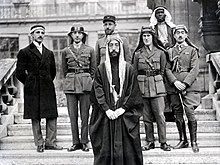
Faisal's delegation at the Paris Peace Conference

Spheres of Interest in the Middle East after the Sykes-Picot Agreement

Map of the territorial division of Austria-Hungary according to the Paris Suburb Treaties
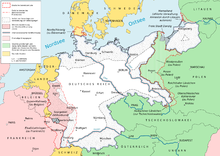
German territorial losses due to the Treaty of Versailles in Europe

William Orpen: The Signing of Peace in the Hall of Mirrors. The representatives of the victorious powers while Johannes Bell signs the peace treaty for Germany on June 28, 1919.
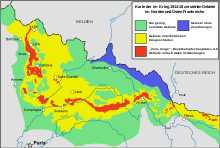
War-damaged areas (Zone Rouge) in northern and eastern France

Bronze memorial plate with the coat of arms of the tsar on a memorial stone for Russian fallen 1914 to 1916. Location: Luftwaffe barracks Wahn

Begging war invalid in Berlin, 1923

Monument in honor of the fallen soldiers in Gräfinau-Angstedt (Thuringia)
Questions and Answers
Q: What was the name of the war before World War II?
A: Before World War II began in 1939, World War I was called the Great War, or the World War. Other names are the Imperialist War and the Four years War.
Q: How many countries were involved in WWI?
A: There were 135 countries that took part in World War I.
Q: How long did WWI last?
A: WWI lasted exactly 4 years, 3 months and 2 weeks.
Q: Who were on opposite sides during WWI?
A: The two sides during WWI were the Allied Powers (mainly Russia, France, the British Empire and later the United States) and the Central Powers (mainly Germany, Austria-Hungary and the Ottoman Empire).
Q: What new weapons were used during WWI?
A: During WWI, tanks, airplanes and submarines (or U-boats) were important weapons.
Q: When did Russia leave WWI?
A: In 1917, due to a revolution in Russia, they left the war in March 1918.
Q: What caused an end toWWI?
A:The war was ended by signing of many different treaties with Germany's government collapsing after running out of men as well as being heavily impacted by an influenza pandemic from January 1918 to December 1920.
Search within the encyclopedia
